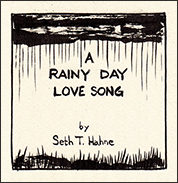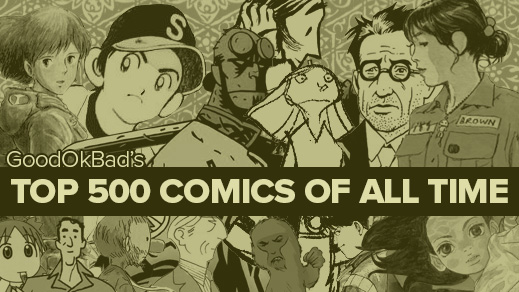

This is picks 101-200 of Good Ok Bad's Top 500 Graphic Novels Of All Time. Follow the links below to get elsewhere in the list.
101–110111–120121–130131–140141–150
151–160161–170171–180181–190191–200
My Best 500 Comics Of All Time (101-200)
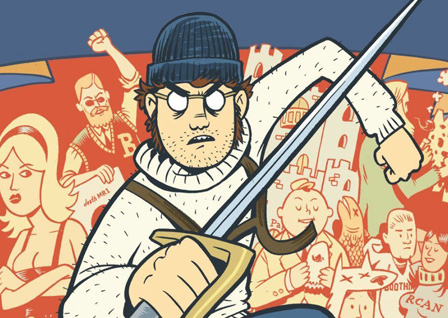
Far Arden
by Kevin Cannon
382 pages
Published by Top Shelf
ISBN: 1603090363 (Amazon)
Comedies are ridiculously difficult to pull off over the long haul. Generally, their shtick gets a little long in the tooth well before the halfway mark and the same would have held true for Far Arden had it not gradually developed into a compelling story with decently well-realized characters.
Following Army Shanks, a man “as cold and unforgiving as the Arctic herself,” author Kevin Cannon treats the reader to a bizarre journey through arctic locales and jaw-dropping onomatopoeia. Shanks makes his way through fishing villages, queer universities, and frozen islands (which apparently actually exist in that nefarious and frigid land known as Canada) along with an entourage of friends, enemies, and former friends and former enemies. All to the end of finding Far Arden, the mythical island whose discovery has devoured (and will devour) the lives of almost every principle character in Cannon’s book.
Throughout the book Cannon skirts the border of believability, never quite falling into a world that jibes with reality, but never going so far into fantasy that we don’t understand there are certain mortal rules common to both our reality and his. Relationships tack as they do in our world, those mauled by polar bears don’t get up, and ambition can kill. That said, there are golden narwhals that will direct willing sailors to paradise. So you’ve got that going for you.
For those curious about the art style of the book, Kevin Cannon apparently began the book as part of an extreme 24-hour comic experiment—instead of creating a whole 24-page comic in a single 24-hour sitting, he would perform a year’s worth of these sittings monthly to create a single, large book. That lasted for four months, so each of the first four chapters were created in a discreet 24-hour period. After that, he adopted the same style but slowed down his pace to one chapter per month—though not in a single sitting. (I believe the additional time spent shows.)

Uncomfortably Happily
by (translated by Hellen Jo)
576 pages
Published by Drawn & Quarterly
ISBN: 1770462600 (Amazon)
I complain a fair amount about autobio, because often (probably even usually) it's obtuse or aimless or doesn't really have any real narrative trajectory. Also, unless the author is very specific in their aims, the work meanders and really isn't about anything beyond scattered snapshots of a life lived with little sense of understanding What Actually Happened. A lot of this can be mitigated by choosing a succinct pericope and essentially making your autobio comic about The Time I Did This And This Happened And Here's What I Got Out Of It.
When I first picked up Uncomfortably Happily, I winced to find it was autobio. At 576 pages, aimless navel gazing for the duration might actually kill me. Fortunately, Hong gets it. He knows what he's doing and does it well.
Hong and his wife are artists. Hong has been in comics for 14 years and his wife, a former student, is just attempting to get her career off the ground with a couple quirky children's books. They get fed up with the cost and chaos of life in Seoul so they move to a remote house up on a lonely mountain if order to work more freely. Uncomfortably Happily is the story of the year they spent there, what happened, and how it changed them.
We see their joy and interest in the move, Hong's early budding reticence, and their realization at just how much work living provincially will cost. We see how each deals with the loneliness, how cold and hard winter can really be, and how Hong begins to lose his freakin' mind. And then we see the rest of it.
Beyond the fact that Hong tells his story well, there were two principal things I deeply appreciated.
1) We see intimately Hong's struggle as an artist desiring to do work he considers valuable and of merit but needing to take on other people's contract work in order to keep the phones on and the house heated (spoiler: these things don't always get done). There're a lot of moments when there are two or three Hong's on panel talking with each other, arguing about what to do or how to live. Hong feels like a failure, constantly fielding revisions from his editor on books that never see substantial royalties. As an artist myself (and comics artist) who struggles to find time to work on my own projects and makes ends meet in graphic design, I found many moments of myself in Hong.
2) As Hong (the character in the book) gets sick from burning candles at weird ends and his depression and anxiety and anger at life overwhelm him, Hong (the author of this story) dives into non-literal representations of things. Animals talk, his comics come to life, things get kind of crazy. It was an unexpected direction and it elevated the work for me to see him portray his inner struggles with such fancy.
There might be something better out there, but for my money so far, Uncomfortably Happily is the best comics autobio of 2017 by a pretty wide margin.

The Gigantic Beard That Was Evil
by Stephen Collins
240 pages
Published by Jonathan Cape
ISBN: 1250050391 (Amazon)
All stories are necessary lies, says Stephen Collins' narrator. And also, the point of everything seen is to keep hidden the unseen. So stories then must serve two purposes, to hint at that which is hidden WHILE further obfuscating what lies beneath.
As fable, or better as parable, The Gigantic Beard That Was Evil accomplishes both of these things, hinting at the hidden by critiquing the visible (society and its common—and often celebrated—artifices) and simultaneously being vague enough that you can't quite make out exactly what it wishes to unveil. It, in a sense, allows you to pick your target.
TGBTWE is Stephen Collins first graphic novel. It doesn't show. The book is a masterpiece and certainly a part of the 21st century canon were there to be such a thing. The narrative flows well, the script both smart and crisp, the page design a formalist's Christmas, and the art lovely to look at. The book is a joy. It might even be stunning.

Stand Still Stay Silent
by Minna Sundberg
4 vols
Self-published
Read (here)
Post-apocalyptic zombie fiction has never been better. Which is good because the post-apocalypse is pretty well played out and man do I hate zombie fiction. But Sundberg's vision here is almost entirely unique in every way.
1) The remaining civilized world is so far limited to Iceland, fortified pockets of Norway, Sweden, and Finland, and a single island of Denmark. That's a rare and interesting setting for a story told in English.
2) The zombies aren't zombies like we typically think of zombies. There're also corrupted beasts and now a bunch of super-interesting ghosts. And an eight-legged horse that's kind of a ghost boss thing. The lore of this new world is extensive, detailed, and imaginative.
3) Sundberg's art is gorgeous. It's luscious and the way she affects mood through colour is essentially like nothing I've seen.
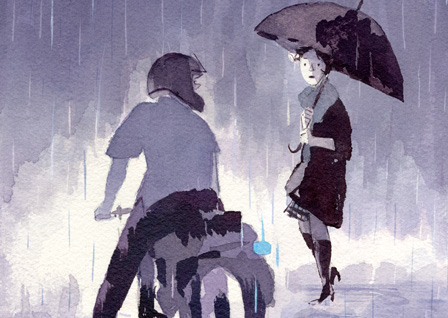
5000 Kilometers Per Second
by Manuel Fior (translated by )
144 pages
Fantagraphics
ISBN: 1606996665 (Amazon)
A boy and a girl and their relationship to and apart from each other evolves over both distance and time. A story about the way we are broken and can break one another and whether there might be solace regardless. Beautifully painted.
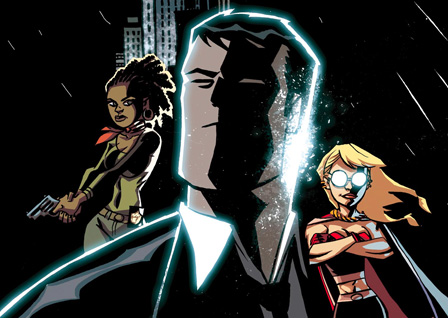
Powers
by Brian Michael Bendis and Michael Avon Oeming
15 vols
Image/Icon
ISBN: 140128745X (Amazon)
Despite some occasional but pretty serious problems with page design and a publishing concept that's just bizarre (vol 15 and 16 retitles the series as POWERS: THE BUREAU vols 1 and 2, then vol 17 is POWERS vol 1)—despite that, POWERS is a solid series, one of the long-running gems of the form. In a way, it's kind of ALIAS before Bendis invented ALIAS.
The basic idea: Walker used to be a AAA superhero back in the day. Now that he's lost his powers, he's a homocide detective, one of a few who specialize in murdered superhumans. He and his new partner Pilgrim investigate crimes, murder-of-the-week fashion until the story really gets going. At that point, status quo is out the window and things go from bad to crazy to worse to maybe a little beter to are we in hell to not quite but maybe next week.
The whole thing is wild and interesting and probably the best thing Bendis has done since ever. I loved his DAREDEVIL, ALIAS, and ULTIMATE SPIDER-MAN, but POWERS is something special. I wish Bendis and Oeming had the time/circumstance/inclination to prioritize this into a monthly title so we could get to its conclusion sometime reasonable. Like maybe he could take 2 years off from Marvel/DC shenanigans and just script the whole rest of the series and then turn Oeming loose on it. It's coming out at nearly Lutes/BERLIN levels of graduality.
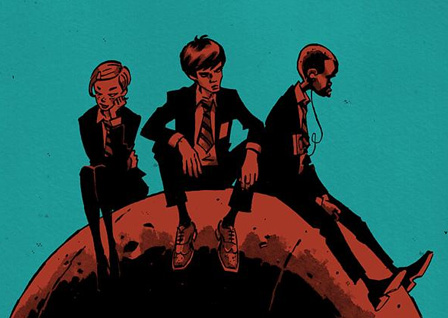
The Motherless Oven
by Rob Davis
160 pages
SelfMadeHero
ISBN: 190683881X (Amazon)
Motherless Oven is one of those wild, bursting-with-imagination stories. Davis crafts a world that we'll never be able to expect or entirely grok the rules for. It's funny and turbulent and only ever hints at what it is itself all about. And I liked it for that. It's a world where children, whose origins remain veiled, build and maintain their own parents, know the day of their deaths, and can change the season with an ill-advised flick of a switch.
The book traffics in absurdity but ties it together with a strange sort of ruleset (known wholly by Rob Davis alone, if even him).
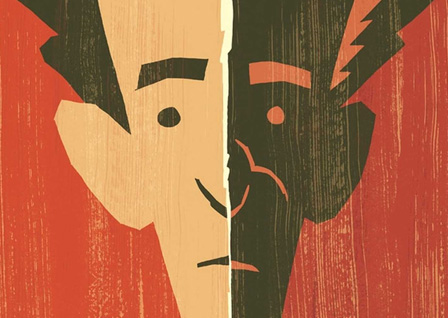
Two Brothers
by Gabriel Bá and Fábio Moon
232 pages
Dark Horse
ISBN: 1616558563 (Amazon)
Two Brothers is foremost a book to be laid on a coffee table so that guests will have something astounding with which to occupy themselves while you futz around in the kitchen preparing exotic teas and fancy adult beverages. It is a work of beauty. Dark and grueling, yes, but beautiful for all that. Bá has always held a little dynamo of the kind of expressive shadowed minimalism that makes Mike Mignola's art the most magnificent stuff to ever grace the earth, and the choice to publish Two Brothers without colour forces that to be on full display. There were pages I stared at overlong just trying to understand how they were accomplished.
As for story, Two Brothers won't likely have you asking existential questions about faith and purpose and meaning. It is, instead, pretty firmly rooted in the pre-20th century family of novels dedicated to charting the collapse of a family or dynasty. From its first pages we know where things are headed and our goal is only to lend an ear while the fall of the house of Halim is laid out like funeral clothes, that we too might mourn the passing of a well-meant but ultimately self-destructively selfish family.
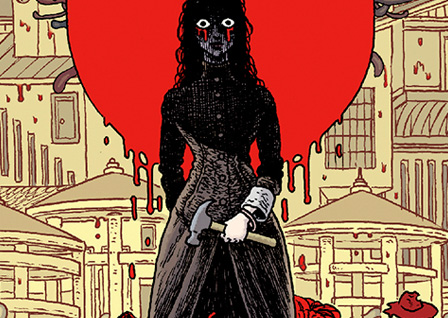
House of Penance
by Peter J. Tomasi, Ian Bertram, Dave Stewart
176 pages
Dark Horse
ISBN: 1506700330 (Amazon)
Man. This thing was an incredible experience, mostly from the art but the writing made room for the art and that's respectable. It's gorgeous and grotesque.
It's basically hyperrealized biography of Sarah Winchester (of California's famous Winchester Mystery House). The barebones of the history is that Sarah Winchester married into one half of the Winchester Repeating Arms ownership. Her husband and 5yo daughter died and she kind of went a little haywire with depression, moved out to San Jose, California and started work on a house (possibly to comfort the spirits of a) her husband and daughter and b) the spirits of those slain using Winchester guns. She spent basically $23K a day building, tearing down, and rebuilding the great house (at its height, possibly 7 stories, but after the SF quake only 4). There are doors and staircases that lead nowhere.
Tomasi and Bertram embellish the legend and make her truly bonkers but also sympathetic. The book is deliriously full of hallucination and visual metaphor. It was a wild ride.
Strangely, though, they got the year and age of her death really wrong.
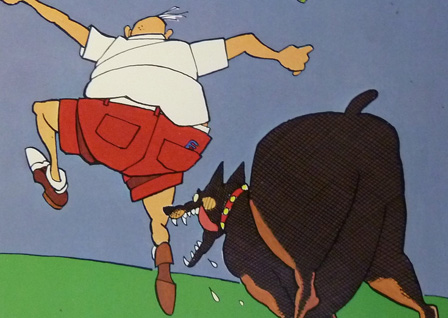
The Neighborhood
by Jerry Van Amerongen
daily strip
Andrew McMeel
ISBN: 0836218469 (Amazon)
I mentioned earlier how Calvin & Hobbes came on the seen and gave me a new place to hang my hat as a religious reader of the daily funnies in the LA Times. Well during that same time, I'd become hip to the absurdist wonder of Jerry Van Amerongen's The Neighborhood, each day a single panel gag revolving around the eccentricities of some random member of the community (there were no recurring characters). Some examples:

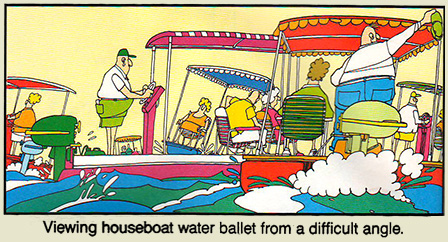

I'm not sure who the actual intended audience for these was but I know that as a 6th grader, I was in love. His bizarre human shapes, his lovely sense of humour, his way of rendering pretty normal things as obscenely strange but then rendered again normal by the reactions of the sighing, eye-rolling, put-upon members of the neighborhood. It was all perfect for me then, and honestly, it's perfect for me now too.
101–110111–120121–130131–140141–150
151–160161–170171–180181–190191–200
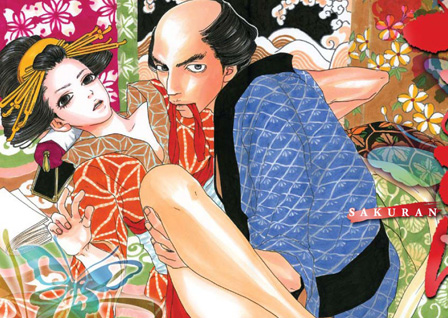
Sakuran: Blossoms Wild
by Moyoco Anno
308 pages
Vertical
ISBN: 1935654454 (Amazon)
Moyoco Anno’s book is about women in distressing circumstances, and throughout I felt the weight of the whole history that has arrayed itself against the female existence. I think of my wife, my daughter, my mother, my friends, women I know from the internet, and women I don’t know at all and will never know. Societies over the long centuries and societies in this very moment have not made living the kindest of experiences for women—societies governed and purposed by my people, by men. I hate us for these inequities and a book like Sakuran fills me with tidal waves of regret and sadness, even if that is not its purpose.
Moyoco Anno’s Sakuran concerns Kiyoha, an 18th-century courtesan who is destined (by Anno’s pen) to become the most celebrated of all the houses in Yoshiwara. Anno begins by introducing Kiyoha as she nears the height of her fame and then peels back for the rest of the book to chart the woman’s course across what turns out to be a hard and bitter sea. Kiyoha is a “strong” female character in the sense that she survives to better herself through her experiences; but simultaneously, she is not immune to her circumstances and her life of prostitution under contract to her house takes evident toll on her. She realizes the world she’s trapped by is terrible and makes the best of it, but she never shies away from acknowledging the reality that her role as courtesan is dominated by paternal influences.
I have it on pretty good authority that “sakuran” refers to confusion or derangement or mental agitation. The book’s subtitle Blossoms Wild, as well as an apt description of the madness of Kiyoha’s blooming sexuality under such a terrifying commodification of the female self, seems pretty probably a play on the homophony between sakuran and sakura, the Japanese term for cherry blossoms (and one of the more well-known Japanese words in America, thanks to the influx of manga and anime imports). Kiyoha’s maturing and sexual bloom within the walls of the pleasure house is agitating for the character as well as for the reader. It seems trite to compare our distress to hers, but it’s Anno’s implication of the reader into the intimacies of Kiyoha’s decade of depetaling (I recognize the preciousness of describing a woman’s initiation into coupled sexual experiences as “deflowering,” but Anno almost pushes the description by her title—as well, the coercive nature of Kiyoha’s sexual engagements are rapacious and demanding and strip her of any of the tenderness we treasure in the potential warmth of the sexual act) that provokes the reader to empathize with Kiyoha’s state—even if to a lesser degree.

Irmina
by Barbara Yelin
228 pages
ISBN: 1910593109 (Amazon)
Genre notes: war at home, romance
The fact of Nazi Germany haunts the 20th century (and even still the 21st century) like a particularly strident and pernicious spectre. How? How! How on earth could Nazi Germany have been allowed, been encouraged?
A few years back Barbara Yelin discovered a box of her grandmother's letters and diaries. From that box grew the story of Irmina, a young woman who in 1934 was living abroad in London, gaining skills and forging a path for a future in which she could grab anything she wanted for herself as well as any man could. She is of course young and with youth comes naivete, willfulness, self-righteousness, and a colossal kind of self-centered ignorance. Still, how could that young woman of raucous attitude and vivacious heart be tens years later passively complicit in the Nazi machine, buying into (to some degree at least) the promise of volksgemeinschaft?
How could a young German post-suffragette proto-feminist go from being fiercely, desperately in love with a black man from Barbados and openly mocking Herr Hitler in the streets to working in the Reichskriegsministerium and chiding non-gung-ho friends with threats of reporting (I show some of this evolution in the accompanying pictures). From 1934 and though 1945 and then to 1983, Irmina paints a portrait, not just of a particular woman through the global scene of the 20th century, but really of how these vast shifts of paradigm are acquiesced to and adopted by the "ordinary" citizen.
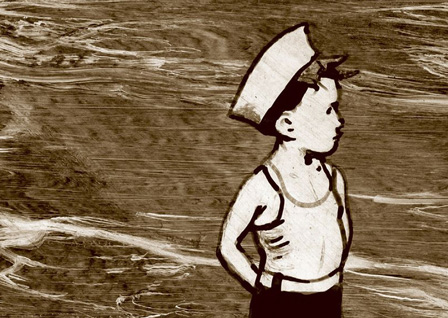
How the World Was: A California Childhood
by Emmanuel Guibert, Kathryn M. Pulver (translated by)
160 pages
First Second
ISBN: 1596436646 (Amazon)
I am not old but I’m not young either. I was born in the early ’70s and so was part of perhaps the last bulk of free-range children. We roamed neighbourhoods in packs or on our lonesome. We hiked in the local wildernesses on our own or perhaps with a friend, rattlesnake buzzing be damned. Our parents routinely left us in the car to play while doing a half-hour of grocery shopping and no one was at all concerned. The smog in Los Angeles was so thick and constant that skies were perpetually orange and it often hurt a child’s lungs to play and on bad days you couldn’t see further than a hundred yards. Payphones were essential lifelines. Dialing a phone number containing nines and zeroes might have taken eternities. Not every middle class family owned a computer. People were afraid the D&D players were sacrificing each other in bloody masses in underground tunnels. And the difference between my childhood and my father’s immediately-post-WWII childhood is as vast as different between now and 1980. Worlds tilt and shift and change, and if we don’t tell these stories, no one will remember to care.
For this reason, Emanuel Guibert’s treatments of Alan Cope’s life are essential and fascinating. How the World Was follows on the heels of Alan’s War, which largely concerned itself with Cope’s place in WWII and its aftermath. How the World Was winds back the clock (another thing growing less and less common) to explore Cope’s childhood growing up in Southern California during the Depression. And it’s a world-and-a-half away from the Southern California I grew up in.
Guibert recreates a number of Southern Californian environments now lost to time save but for the archival efforts of photograph collections and artistic renderings. They portray another kind of world and will be fascinating to students of human history and nature. Scenes from the early 20th century abound. Soda shops, old-town L.A. County, the boardwalk at Santa Monica, simple Depression-era housing. Leave it to a French work to inculcate a nostalgia for a thoroughly American world now lost to us for all time.

Bad Machinery
by John Allison
7 vols
Oni Press
ISBN: 1620100843 (Amazon)
When I was a budding teen, I was probably just about what you were like. I was whip-smart, sardonic, and had no problems elucidating my every bursting thought with exactitude. I was, for lack of better description, charming. I wouldn’t go quite so far as to say “debonaire,” but really that’s probably just modesty speaking. I dressed well, spoke well, and forged relationships well. With either sex. Didn’t matter. I was basically the stuff. Except for the fact that none of that happened. I was instead probably just about what you were like. I was, for all my smarts, a bit of a moron. Couldn’t properly express myself. Flummoxed and self-concerned around both boys and girls, but unconquerably so around girls. And then throw on top of that the fact that I was, as J.M. Barrie describes children, innocent and heartless.
Again, I was probably quite a bit like you. Not because you were a particularly horrible person but simply because budding teens are not very good at being the people they have the potential to be. Junior high is a terribly awkward stage. Our bodies are wrong, being trapped in the uncanny valley betwixt the hopefully adorable child-self and the hopefully awesome adult-self. Limbs jut out here and there in clumsy efforts to rush toward that which we yet aren’t. Breasts leap from the canvas of our bodies. Unwished for erections make tents of our jeans. Strange thatches and patches of hair appear at first as if mirages. New smells collect around us. The blood times, the nighttime ejaculations, the hormonal spasmatics. It’s a tough time to be a person. And all these physical oddities combine with the other demands and expectations of growing older to temporarily hobble the psychological state of the young. Stew all this together and you’ll find that people in the age range of twelve-to-fifteen are some of the most difficult, squirrely, and (sometimes) unlikeable people you know.
And it’s not like its their fault. It’s understandable. It happens to all of us. I just maybe don’t want to read about such people. So the more realistically a book portrays its young teen protagonists, the more I find myself distanced from any ability to enjoy the work. Harry Potter and the Order of the Phoenix was nearly unreadable to me. Harry was so thoroughly unlikeable and whiny and stubborn and blind and conceited because Rowling did a fair job at approximating what a good kid in Harry’s position would be like. I hated nearly every minute with him. It got to the point that I wanted him to lose just so it’d knock some sense into him. I mean, congrats to Rowling on writing a believable fifteen-year-old, but I almost left the book unfinished because of her triumph. So then, I’m glad for what John Allison does in Bad Machinery, a book thoroughly concerned with the lives of budding teens.
I’m not even quite sure of the alchemy by which he does it either. Most authors, having recognized that realistic teens are neither enjoyable teens nor entertaining teens, ditch the idea of realism and simply write their characters as adults in kid bodies and then strip out the more, quote-unquote, adult habits (drinking, swearing, sexing, stock-trading) from their characters. This leaves their young protagonists free to operate in generally reasonable demeanor and not flip the heck out over what adults might consider trivialities. It’s okay so far as it goes, but always ends up feeling a bit hollow. Allison, somehow, finds a warm place in between whereby his characters can carry on conversations like ridiculous, amusing, meta-witty young adults while simultaneously skirting into realistic interaction with their world.
Bad Machinery is one of those strange Modern Hybrids that we’ve seen rise up with the advent of the web and its associated comics. The series unfolds in the macro sense over a series of mysteries. These arcs resolve themselves under the taxonomy of cases. The first is “The Case of the Team Spirit,” which is followed by “The Case of the Good Boy.” There are currently eleven (I think?). Within each case however, each page is revealed a day at a time to the reader—and in common webcomic fashion, these each usually resolve in something like a punchline. The story unfolds across these brief punctuations with time and place often shifting dramatically from one page to another. Still, it all keeps together well, and it may be that the promise of a joke or witticism or revelation at the end of each page actually works to spur the reader onward. After all: it’s easy to bookmark a page and let go for the night if you know you’ve got another thirty pages ’til the next breaking point. Not so easy to let go when there’s a breaking point every page—not enough pressure to stop when it’s only a thirty-second read to get to the next rest area.
Allison’s series is the tale of boy detectives. And girl detectives. Youthful detectives, at any rate. Of either sex. They work, sometimes together and sometimes at odds, to solve various mysteries. It's basically like Scooby Doo except whereas in Scooby Doo every unearthly mystery had a very mundane cause, here every mystery begins easy enough but soon plays court to the supernatural. The reason I may not have noticed this is that even though there’s plot for each of these arcs and you really do want to know how things are going to piece together, the real reason you’re devouring these stories is Allison’s magnificent characters. The kids, who alternate in good measure between realism and wonderful fantasy, are deliciously wrought. Their interaction and distinct personalities mesh so well together that I worry for them as they age, knowing that they’ll eventually all move in their own directions—and we actually see some of this unfold across the years represented in these cases. They start out the series at the ripe old age of 12 years old and in the current case, I believe they are straddling the land of 17 years old or something around there.
Also, these are some of the funniest comics around. I forget if I mentioned that.
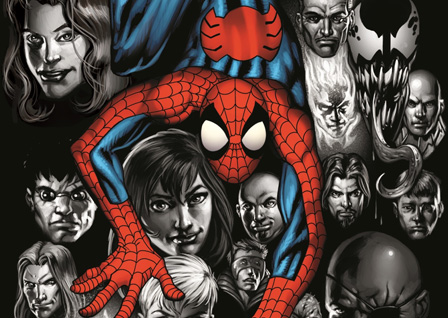
Ultimate Spider-Man
by Brian Michael Bendis and Mark Bagley
22 vols
Marvel
ISBN: 0785124926 (Amazon)
Okay, so Marvel and DC hero comics are a trash heap, right? RIGHT?! (Stay with me even if you disagree and think I'm a bum now.) So why recommend one? Because every so often, even if pretty rarely, they overcome the inertia of their marketing paradigm and make something pretty worthwhile. Ultimate Spider-Man overcomes those forces for as long as it can and is often pretty great. Until Marvel ultimately pooped on the whole thing. But until then, it was solid.
So I've talked about Marvel/DC hero books as not being about characters at all but instead about storytelling engines before. Essentially it goes like this: these books don’t actually feature Character in any honest sense of the term. Instead, they feature storytelling engines. Or maybe better, storytelling prompts. A reader of Spider-Man in 1970 can more or less jump into Spider-Man in 2010 and pretty much know exactly what’s going on. Only the trivialities (like who is punching Spider-Man now) have changed. Same with Superman, Batman, Captain America.
Spider-Man is merely a series of tacitly connected short stories set in the same world and using the same set of character-props. Where characters have arcs and growth and progression, the whole point of Spider-Man or Batman is to tell Spider-Man or Batman stories. They can never be allowed to stray from archetype because they are not characters, but product generators. That’s why I couldn’t stay invested. There was nothing to invest in. There’re only so many times that you can read the biographies of Abraham Lincoln before you—for your own sanity probably—have to move on to other biographies, to other persons.
That's one of the two reasons I stopped buying superhero books back in 2006. The other reason were the crossover events. They infected everything. They stomped all over whatever stories were being told. It's stupidly hilarious to get an omnibus collection of stories from any point after 2005. I'd heard good things about Brubaker's Captain America, so I picked up the omnibus and it was really pretty great and then suddenly all these crazy abrupt things and character changes were happening. It made no sense at all *until* I realized that there was some crossover event or other creeping in and changing everything. It'd probably make sense if you were following both things concurrently, but otherwise, it's really weird.
Anyway, because Ultimate Spider-Man takes place in its own little world, it takes a good while for these two problems to take hold. Add to that the fact that Ultimate Spider-Man is pretty nearly the platonic form of Spider-Man and you've got a nice, enjoyable adventure soap.
USM begins with Peter getting bit, there's the Green Goblin and Doc Ock and Kingpin and everyone, but they're all rewritten from the ground up. There is no prior continuity and it's great. Really early on, Peter tells his new girlfriend Mary Jane that he's Spider-Man. Gwen Stacy comes along eventually. Venom. Wolverine. Black Cat, Daredevil, Flash, Kitty Pryde, etc. The usual cast and crew. Only they're all new and all different. Eventually, the book does start to feel some bloat, but Bendis is so very dogged on focusing on this as Peter's book (rather than Spider-Man's) that his small group of regular teenage friends anchor everything and keep it from wallowing in tights and excess.
And Bendis, amazingly, writes Peter and this book pretty much better than nearly anything he's ever done. All of his Bendis-y tics and tropes just really work well with this version of Spider-Man.
Eventually, Marvel marketing *does* catch up to the book, first to ruin everything with a big Ultimate-Universe crossover that is terrible and stupid BUT does create one of the most poignant issues in Marvel history, when J Jonah Jameson realizes, startled, that he has been 100% wrong about Spider-Man and becomes his biggest booster. Then, in the strangely on the nose arc "The Death Of Spider-Man," Marvel kills Peter in another big event. This isn't really a spoiler because the book is actually called The Death Of Spider-Man. Amazingly enough, Bendis keeps the ball alive by introducing Miles Morales, a black Latino kid who becomes the new Spider-Man and his story is possibly even better than Peter's. This continues for five volumes before Marvel irrevocably destroys the whole thing for all time in a line-wide event that actually destroys the Ultimate Universe. Miles' Spider-Man is brought into the regular Marvel universe, at which point you never need to read again because his whole cast is gone or changed and he's screwed tightly back into the whole reason I got out of their comics.
But man, while the series is good, it is so good. Just simple fun adventure.
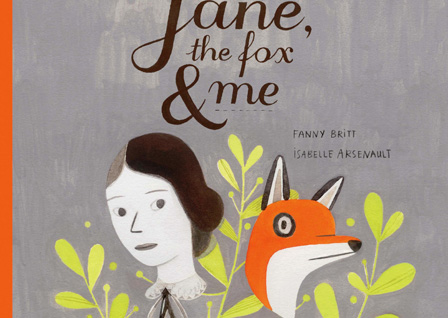
Jane, the Fox, and Me
by Fanny Britt and Isabelle Arsenault (translated by Christelle Morelli and Susan Ouriou)
104 pages
Groundwood Books
ISBN: 1554983606 (Amazon)
This was a surprisingly lovely story, if only because lovely things always catch me off-guard. It's about a girl who is concerned about her weight and feels the brunt of social antagonism at her school (even though just a year prior she was friends with all the popular girls). She also likes reading and over the course of the story moves through the text of Jane Eyre. It's sweet without succumbing to that overly treacle sentimentalism that costs too many books their laurels. And it's beautifully illustrated.

Cape Horn
by Christian Perrissin and Enea Riboldi (coloured by Studio KMzero, Diego D'Aquila and Sebastien Lamirand, and Hélène Lenoble and translated by Quinn and Katia Donoghue)
232 pages
Humanoids
ISBN: 1594651302 (Amazon)
Cape Horn tells a story of 1890s Tierra Del Fuego, a place steeped in colonial interest. From soldiers to mercenaries to missionaries to vagabonds to the native Yámana people, Cape Horn (the book) is filled with different people with different goals and different identities. Few come to find happiness, but adventure rules the day.
Cape Horn is thrilling and gorgeous and occasionally even thoughtful. This was my #5 Best Graphic Novel of 2014.
And as an added bonus, every time I say the title, my wife hears K-porn (like how Korean pop music is called K-pop). So that's always good for a giggle.
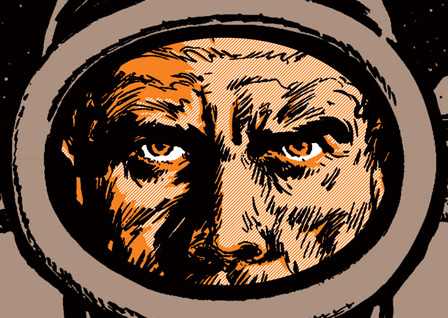
The Eternaut
by Hector German Oesterheld and Francisco Solano Lopez (translated by Erica Mena)
372 pages
Fantagraphics
ISBN: 1606998501 (Amazon)
The Eternaut surprised me. I know it probably shouldn't have. Everyone was telling me to read it. But still.
There's this thing about a lot of older works that are well-venerated. Despite all their dignity associated with the place they hold in comics history, despite all the ways they influenced what we see in the field today, and despite all the ways they were actually really really good for their time—despite all these very important and legitimate things, many of the great works of the canon feel hackneyed and primitive when stood next to our contemporary greats. And no shade there, really. We should expect this. We should expect that when giants stand on the shoulders of giants they should loom much larger.
So when another wonder from a half century ago gets repackaged handsomely for a contemporary audience, I'm reluctant. I've been burned too many times, thinking I might find jewels relevant to my reading interests today. I imagine that somehow some long dead author might have anticipated the cultural condition I find myself in and have written to my particular milieu. And while that's at least plausible when we're talking about novels (after all thousands and thousands have been published every year for centuries), far fewer comics have been published and so the chance of genius spilling across time becomes slim.
The Eternaut, though. Man this feels fresh. Apart from some idiosyncracies native to the format limitations (one page per week in a newspaper), the book reads well. It's a longform, succinct story of the Twilight Zone variety that stands well apart from its contemporaries that I've encountered. This is sustained narrative while simultaneously having an end point, unlike the unending adventure-story engines of its North American contemporaries. Additionally, it offers some similar kind of political/historical commentary in the manner that Sonny Liew offers in The Art of Charlie Chan Hock Chye. I rarely feel I'm beholding something special when I read vintage comics, but I felt that with The Eternaut.

Solanin
by Inio Asano (translated by JN Productions, Annaliese Christman)
432 pages
Viz
ISBN: 1421523213 (Amazon)
I first read Solanin almost a decade ago. And I only read it the once. I thought it was a good book, well-conceived and well-produced, but it didn't hit me as one of those books I needed to return to over and over again. It was no Cross Game after all. But needing a good book to recommend here, I thought I'd return to it and see how it struck me all these years later. And, well, it's pretty great.
I've been a fan of Asano since Christmas 2009 when I first got Solanin and What A Wonderful World. I liked Solanin fine, but What A Wonderful World was the one that grabbed me by the lapels—and I didn't even have lapels. I've followed his releases since then and his voice and vision have proven unique and worth consideration. And he continues to rock worlds.
Solanin is about a boy and a girl. 24-year-olds in Tokyo, trying to figure out life. Only not trying too hard to figure out life. Meiko works an office job she hates and Taneda does freelance illustration (bad hours, bad pay). They live together but their future is uncertain. Taneda plays guitar and dreams of his band making a difference, but his pride and self-consciousness prevent him from exerting himself or treating the dream seriously. Their friends occupy similar holding patterns and are governed by the fears and uncertainties native to the human condition.
Will the power of music save their lives or destroy them? Or is there really any power to it at all and does any of it truly matter when on this very day there is a war going on and normal everyday people are dying senselessly? Fans of Ecclesiastes may enjoy this one as questions about the vanity of all things echo its halls. Gorgeous art with some stellar, powerful moments.
And now, with an epilogue volume catching up to characters a decade later, Solanin becomes even richer.

Order of Tales
by Evan Dahm
720 pages
Self-published
Read here
Order Of Tales occurs in the same world as Rice Boy and Vattu, only much before Rice Boy and much after Vattu. In the millennia since Vattu, there is little to resemble the Overside world unveiled in the latter work (Vattu), but there is some carry over from (or into) Dahm's earliest work, Rice Boy. T-O-E, the One Electric appears in both. In Rice Boy he is at the end of his journey, but in Order Of Tales, he is hundreds of years younger and perhaps marginally more idealistic.
Dahm's worlds are rich and complicated and beautifully wrought. Where Rice Boy capitalized on the wild and imaginative, and Vattu emphasized the grand and political through the venue of the personal, Order Of Tales plays heavily on the adventure, the hero, and the nature of the story.
I don't know if Order Of Tales is my favourite of Dahm's works. It might be. It always is right after I read it, but as a creator he's so deliriously talented that a dive into any of his works are well worth the time spent.
It's pretty rare the webcomic that I'll take the time/money to get in physical form, but Order Of Tales is one of those. It's big and hefty and filled with wonders.
101–110111–120121–130131–140141–150
151–160161–170171–180181–190191–200
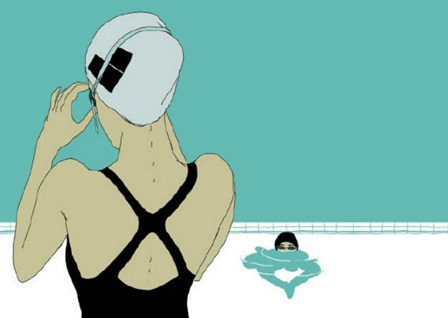
A Taste of Chlorine
by Bastien Vivès (translated by Polly McLean)
144 pages
Jonathan Cape
ISBN: 0224090968 (Amazon)
A Taste of Chlorine is an evocative treatment of language, of the wonders and woes of the human spirit’s attempt to connect to others of the like. Bastien Vivès seems focused on the elusivity of that connection and the concern that even physical proximity can be alienating if language falters. In Taste of Chlorine, art and design and story conspire to sing a kind of methodical lament, a series of mechanical refrains meant to mirror the repetitive nature of the act of swimming while simultaneously signaling an anthem to the soul who struggles with human connection.
Vivès strikes at how simply we might be distracted from accessing the true meaning of words. A Taste of Chlorine incisively intimates how easy it is for two people to remain foreign to each other—to be shuffled from the path of understanding and hope by little more than a misplaced word and an absence of meaning. This is the story Vivès toys with and his art throughout drives this home.
For a work concerned foremost with communication, Vivès spends surprisingly little time on actual dialogue. He lets his art speak for him and for his characters. The story moves through the stealing of glances, the submergence of physiques, and what is revealed above and below the waterline.
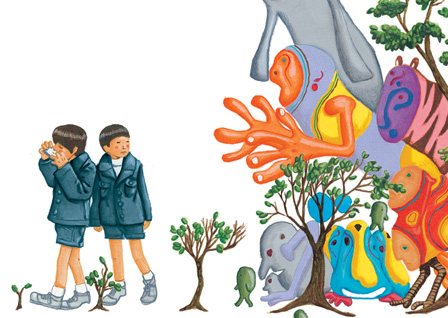
GoGo Monster
by Taiyo Matsumoto (translated by Camellia Nieh, lettered by Susan Daigle-Leach)
464 pages
Viz
ISBN: 1421532093 (Amazon)
Gogo Monsters straddles some sort of line between absurdist, surrealist, and fantasy. It can be difficult to follow because the reader will often be uncertain whether the experiences depicted should be considered reality, imagination, or metaphor. There are textual cues that led me to vote for Reality, but you never know.
Matsumoto’s story, in its most overt, surface reading plays out over the course of a year and follows the story of a school that is increasingly beset by misfortune and misbehaviour. More properly, the plot may be said to concern three children in varying stages of social pariah-dom. Makoto, a third grader, is the most even-keeled of the three and spends most of his time alternating between interest in and alienation from his bizarre classmate Yuki. Yuki sees visions of another world, one that overlaps with our own, and he attributes much of the gathering social darkness to the activity of the other-worldly “others”—though the flame of his faith is being somewhat diminished by recent conversations with IQ. IQ, a mathematical genius, is a fifth grader who wears a cardboard box over his head at all times and sees Yuki’s beliefs about the other world as mere psychological extrapolations of his intense feelings of loneliness. IQ and Yuki are explicitly shunned by their classmates, while Makoto hangs on to some degree of social relevance despite concerns about his curiosity toward and friendship with Yuki. As these characters wend their way toward their individual fates, Gogo Monster may or may not (depending on one’s interpretation of events) reveal whether Yuki’s imagination has gotten away from him or not.
It’s a curious book and each reader’s interpretation will lead into a variety of questions about authorial intent and whether Matsumoto merely intended to tell the kind of trippy story that high-school–aged writers love to think is amazing and mind-blowing—or whether the author has bigger fish to fry. Matsumoto lays a lot of groundwork for a robust interpretative challenge and Gogo Monster is a thought-provoking work—and that alone is enough to recommend it.
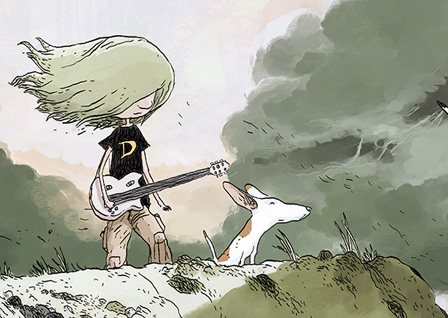
Doomboy
by Tony Sandoval
136 pages
Magnetic
ISBN: 0991332474 (Amazon)
Id has lost his love. She's gone and all he has left is metal. And one friend, maybe two. And a radio to broadcast on. He finds a spot on the coast and tries to express through one final cataclysmic metal masterpiece the depth of his heart. What he believes to be a performance to the void alone turns into something much more.
Doomboy has a pretty good story that is easy to forget in the face of Sandoval's magnificent illustrations. The art plays such a strong role that it often even threatens to subsume everything else in the book. Which is almost the perfect way for this crazy book to roll out.
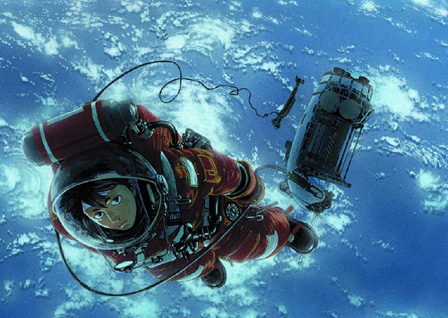
Planetes
by Makoto Yukimura (translated by Yuki Johnson, lettered by Susan Daigle-Leach)
2 vols
Dark Horse
ISBN: 1616559217 (Amazon)
Before Vinland Saga, Makoto Yukimura had this story about space garbage collectors (or more particularly, debris collectors). Also more particularly, it wasn't so much a story as a set of stories. Each explred one more aspect of his cast and their dreams, their nightmares, their motivations, their circumstances, and the question of meaning that lurks behind every life. Planetes is as good a reason as any to give to justify the existence of comics. It's thoroughly worthwhile.
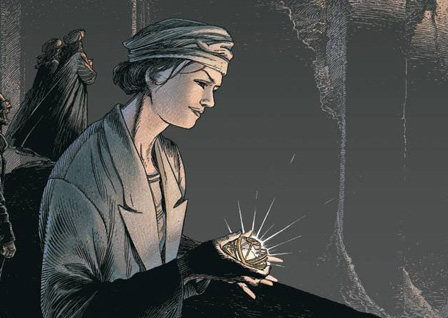
The Theory of the Grain of Sand
by Benoit Peeters and Francois Schuiten (translated by Ivanka Hahnenberger and Stephen D. Smith)
128 pages
IDW
ISBN: 163140489X (Amazon)
Les Cites Obscure is Schuiten and Peeters' realm of fantastic cities and strange events. They exist in a world parallel to our own and many of the cities reflect our own world to degrees (for instance, the Palace Of Three Powers in Brüsel is a near replica to the Brussels Courthouse in, well, Brussels. Les Cites Obscure currently features in thirteen vols in France.
The Theory Of The Grain Of Sand is the second vol to be produced in the US. (I had wanted today to cover The Leaning Girl, which is great, but it's now out of print and used copies go for $125.)
In both US vols of The Obscure Cities, Schuiten and Peeters play on a combination of the overt and unexpected. In the narrative of TTOTGOS concerns the appearance of some weird things: the multiplication of rocks of the exact same weight, a chef who is gradually losing weight but not mass, an apartment that produces sand, and more. But using the visual magic of comics, we find that these things are all related—because as one single character (and no other) can see, these things all shine and shimmer.
It's an exemplary exploration of the imagination and while I prefer The Leaning Girl, TTOTGOS is a strong work that boasts more of Schuiten's incredible linework.
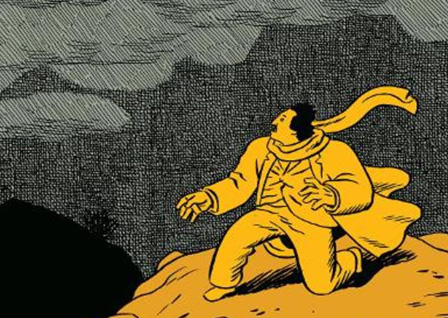
Louis Riel: A Comic-Strip Biography
by Chester Brown
280 pages
Drawn and Quarterly
ISBN: 1894937899 (Amazon)
Biographers, it happens, are every bit as much storytellers as Dickens or Gaiman or Hemmingway or Stoppard. They not only have a responsibility to the historical record, but perhaps more importantly, they are beholden to the attentions of their readers. The occupation of a straight fictionalist almost must be easier—for the simple novelist may take a story in any direction and pace it in a manner that will drive readers to continue until story’s end. The biographer, on the other hand, is more like a film editor who has to craft a compelling story with found material he had no hand in creating. So it’s understandable that biographers might take some license with the truth.
As if truth and history even belong in the same sentence.
Chester Brown, as he unfurls the history of Manitoba’s founding rascal-hero, carefully chooses which directions to have Riel’s story take and which paths the man should tread. Often in his research Brown is confronted with conflicting reports, some from recollections published well and many years after any of the involved incidents. As interesting as Riel’s decisions and circumstances are, it may be still more fascinating to chart Brown’s own choices as to which of these to portray—and how.
Brown is forthright about his biographer’s role in the fabrication of Riel’s historical record—and really, that just makes the work that much more intriguing. Knowing that the author is not bound overly by, quote-unquote, historical fact draws more attention to Brown’s skill as a storyteller. He is unshackled enough that he can tell the story he is going to tell in the way he wishes to tell it. And while there is certainly some subjectivity at work, I can say that at least from my reader’s perch, Louis Riel is an unqualified success.
With its abrupt and overly simplified style, Louis Riel is able to present Riel’s story in a way impossible for a prose novel. Visual space is used to create story beats, punctuating decisions or underscoring the humour in a given situation. Entire conversations, discussions, and arguments occur over two or three panels, with dialogue as spare as Brown’s art. The pacing and storytelling is excellent throughout. Brown attributes the drawing style he employs across the book to his love for Harold Gray’s Little Orphan Annie. Hollow, pupil-less eyes float detached in wide-open faces. Brown’s rendering of these historical figures is iconic and indelible.
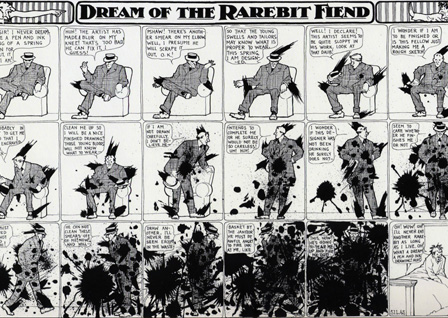
Dream of the Rarebit Fiend
by Winsor McCay
714 pages
CreateSpace
ISBN: 1479106569 (Amazon)
Winsor McCay is largely known for his bizarre and imaginative and colourful Little Nemo comics, which ran in Sunday papers from 1905 to 1926. During nearly the same period (1904-1925) McCay drew a similar strip called Dream Of The Rarebit Fiend, often under the name Silas (for contractual reasons).
Dream Of The Rarebit Fiend follows a similar structure with Little Nemo in that the dreamer becomes increasingly aware of the chaos of their dream and wakes in the final panel (usually remarking on how they should not be eating Welsh Rarebit before bed). But while structurally similar, DOTRF is much more adult oriented, dealing with mature themes like suicide, insanity, social situations, alcohol. Each strip is self-contained and there aren't really recurring characters.
DOTRF, like Nemo, has been published in numerous editions over the years. A few years back Ulrich Merkl released a large (12x17") hardcover edition with a lot of background and history and essays to give context for the series. It sells for stupid amounts on Amazon currently, but if you ever run across a copy for less than $200, it's worth it.
Dover has an 80-page paperback selection of the strips for 12 dollars. The pages are 8.5x11"
CreateSpace has a 714-page edition for 20 bucks. The dimensions are a bit smaller at 7x10" - but the quality of the book is apparently pretty weak with many of the strips too small to read.

Buddha
by Osamu Tezuka (translated by Yuji Oniki and Maya Rosewood)
8 vols
Vertical
ISBN: 193223456X (Amazon)
In Buddha, Tezuka presents a curious blend of themes and styles. This project, ten years in production (1974–1984), presents the life of Siddartha Gautama, the Buddha, from birth to death, capitalizing on famous episodes and creating fictional ones as well. Tezuka includes a robust cast of characters both fictional and historical that waxes and wanes over the near-century that the story narrates.
Not being a Buddhist, I have no idea how well Tezuka’s tale reflects either the historical man or the religious conception of him (though genuine Buddhists do seem to like the book). And I don’t know if Tezuka was Buddhist or not, though it seems likely or plausible. One thing, however, is certain: that Buddhists enjoy the book speaks well of their sense of humour with regard to their faith’s central figure. I cannot see a similar book being crafted about the life of Christ being well-received. And a similar version of the life of Mohammed would end in bombs, death threats, and ambassadors demanding apologies.
Because the thing is: Tezuka’s tale is as irreverent as it is reverent.
He clearly thinks highly of Buddha and his teachings. And yet, the books is filled with jokes and antics and all kinds of nuttiness. Pokes and jabs at Buddha himself are rare (though present), but there is a constant stream of silly asides, even in the midst of what would otherwise be a sober scene fraught with drama. A horse will arrive astride a messenger to deliver dire news to the king. A character will be confronted by his haunted conscience, seeing a vision of Buddha speaking to him—only, since it was a vision, he wakes to discover he’s been talking to his horse all along. Characters from Tezuka’s other works show up not infrequently and even Tezuka himself appears in cameos, taking the place of a character for a single panel.
The story is filled with anachronisms as well. Both visual and verbal. At one point, a poor peasant family wishes to send their son with Siddartha as he follows the path of monkhood, claiming that their son should be able to become a monk “in this day when even actors can become president.” There are further references to Paris and New York and Spielberg. E.T. and Yoda even make appearances, and at one point a royal councilor asks if Buddha actually is E.T. (as Buddha has just healed someone with the touch of a finger).
It took me a while to get a handle on exactly how to approach the book. The fact of the sheer silliness of moments. The fact of the gorgeous and highly detailed landscapes intruded upon by Disney-esque cartoon characters. The fact of main characters who die 300 pages in to the 3000-page epic. The fact that every woman in the book is topless. The fact of mixing faith and fantasy so seamlessly in a book that I believe is trying to promote the teachings of Buddha. And the fact that Buddha isn’t even born until the end of the first volume. It was a weird mix, but after not too long, I found myself quite at home with his unique style and let the story wash over me.
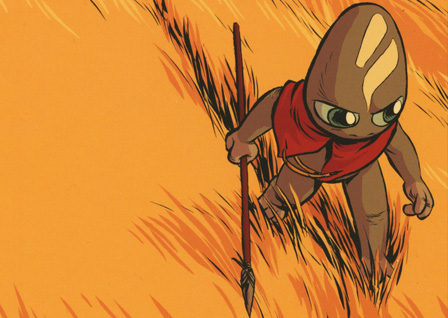
Vattu
by Evan Dahm
3+ vols
Self-published
Read here
While Rice Boy was fascinating and inventive and Order of Tales offered a superb yarn, Evan Dahm's Vattu is his most ambitious story yet—a multithreaded, complex narrative about the crossing of cultures, imperialism on the verge of post-imperialism, the semitotics of identity, and how language shapes us.
While Rice Boy's colours were flat and Order Of Tales was black and white, Vattu is vibrantly coloured with a perfection of details. It's a beautiful book. I'm hungry to see the story complete if only because I 1) love the satisfation of a story concluded and 2) can't wait to see more stories in Dahm's world.

Nathan Hale's Hazardous Tales
by Nathan Hale
8 vols
Amulet
ISBN: 1419731483 (Amazon)
Nathan Hale's Hazardous Tales are amazing. Basically, its a series telling stories from US history geared for young readers. Only, I have kids and I bought the entire set of available books not for them but for me. Because they're such a deep pleasure.
Book 1 is about Nathan Hale, the Colonial spy during the American Revolution whose last words before being hung were "I regret that I have but one life to give for my country."
This sets up the series. While Hale is on the gallows, the Big Book Of History swoops down, swallows him and then spits him out (as is its wont). He now has Complete Knowledge of the full breadth of American history. So he delays his execution by telling stories from US history to the hangman and the British officer attending his execution. It's pretty hilarious and the characters interrupt the stories Frequently to offer asides and whatnot.
- Book 2 is about the Ironclads in the Civil War
- Book 3 is about the Donner Party (for kids!)
- Book 4 is about WWI and is so disturbing that Hale (the author not the spy) gives all the actors animal heads to make it a little Holy Hell.
- Book 5 is Harriet Tubman
- Book 6 is The Alamo
- Book 7 is the Doolittle Raid and WWII
- Book 8 returns to the American Revolution and Lafayette
The way Hale (the author, not the spy) weaves these tales using the fourth-wall obliterating Spy Hale, hangman, and officer as foils is so soooo entertaining. These are stories about heroic deeds and grim doings, but they're told effervescently. Humour, excitement, and education all rolled into one.
One of my favourite parts is this great bit from the Donner Party one, in which the hangman, who up to this point has been so disturbed by the deaths of the travelers' animals (despite being a regular killer of humans himself), decides he can't take it any longer and so he flips forward to nearly the end of the book to skip all the terrible deaths of pets that he imagines will mark the tragedy of the Donner expedition.
Seriously though. These books are so interesting and so educational that I can't believe it took me this long to get to them. In 5 pages, the Alamo one lays out the whole background to the Alamo event better than anything I've ever encountered. The WWI one gave such a great overview of the War that it is now the book I'll recommend to anyone who wants an overview of the that whole trouble.
101–110111–120121–130131–140141–150
151–160161–170171–180181–190191–200
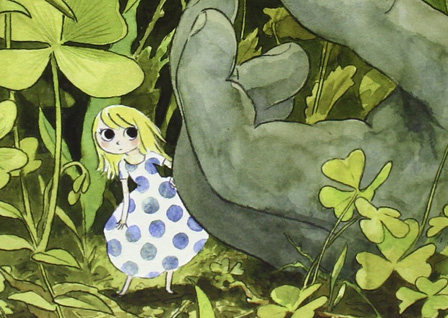
Beautiful Darkness
by Fabien Vehlmann, Kerascoët (translated by Helge Dascher)
96 pages
Drawn and Quarterly
ISBN: 1770461299 (Amazon)
On the surface, it seems pretty straightforward. A young girl dies in the forest and a host of tiny, often grotesque people emerge from her corpse and struggle to survive in the woods. But it really isn’t that simple. There is more there, sometimes under the surface and sometimes squirming on top. I found the publisher’s descriptive text unhelpful and probably actually wrongheaded.
"Kerascoët’s and Fabien Vehlmann’s unsettling and gorgeous anti-fairy tale is a searing condemnation of our vast capacity for evil writ tiny. Join princess Aurora and her friends as they journey to civilization’s heart of darkness in a bleak allegory about surviving the human experience. The sweet faces and bright leaves of Kerascoët’s delicate watercolors serve to highlight the evil that dwells beneath Vehlmann’s story as pettiness, greed, and jealousy take over. Beautiful Darkness is a harrowing look behind the routine politeness and meaningless kindness of civilized society."
None of this reads like someone who actually grokked the work. At least not closely. I may not understand Beautiful Darkness completely, but I do understand that the above reading is incompatible with the text as revealed. Aurora is not a princess. The idea that this is an allegory for human survival against the instinct for societal self-immolation fails to fit the available information. Other reviews invoke Lord of the Flies (which is fine, I guess) but leave it there with William Golding’s critique of the natural human spirit as being essentially depraved (which is not fine, and actually lessens Beautiful Darkness as a mere derivation of a common observation).
I don’t wish to be too contrarian because it’s likely that these readers didn’t understand the book any better than I did. Making too much of something, going for the facile interpretation—it’s an easy trap to fall into when one feels as though they have to say something wise, intelligent, or insightful about a book. I feel that pressure a lot. And I’ve fudged things before as well. So it’s not like I’m blameless. I think I just wished for better criticism because I love this book and want to understand it.
I love this book for what it appears to be. I love this book for the promise of what it might be. I love this book in the same way a sixth-grader might have a world-shattering crush on the girl two rows back in World Cultures. She is seen and heard but ultimately only known tangentially. But still, she is a fixation—and adored. That is Beautiful Darkness to me. It’s lovely and amazing and probably the most perfect thing ever created. Just like that girl in sixth grade you never spoke to and whose real identity remains a mystery to this day. Unattainable and foreign: the perfect crush.

Red Handed: The Fine Art of Strange Crimes
by Matt Kindt
272 pages
First Second
ISBN: 159643662X (Amazon)
While very different from Super Spy structurally, Red Handed does something similar in terms of taking several disparate threads and weaving them together into a satisfying whole. The stories of strange criminals start and stop, each concluding with the perpetrator being cuffed by the city’s super detective, Gould. These are interleaved with artless sections of dialogue. It takes a while to apprehend the pattern—but when one does, it’s hard not to stop and think “Heh” or “Little scamp” or “Whoa” in that kind of way that offers a silent congratulations to Kindt for letting us take part in this twisting genius.
Beyond the conceit of the Twist—that moment in the storytelling when the author turns the tables on the reader and turns the story they were reading into another story entirely—Kindt’s structure for Red Handed allows him to effortlessly break off from his story and engage in a little bit of philosophical discussion about the nature of crime and law. Often in ambitious literary work, these excursions are narrative cheats that authors use to force-feed some added value into what would otherwise be a pretty mundane set of plot paces. While I was nervous for a time that Kindt had stepped into that common trap, Red Handed vindicates itself and Kindt uses these discussions to inform the story and enrich the reader’s participation in its conclusion. In fact, Kindt’s finale would be hollow without the ranging conversation that governs it.

Sailor Twain: Or: The Mermaid in the Hudson
by Mark Siegel
400 pages
First Second
ISBN: 1596439262 (Amazon)
For centuries, mermaids were known as creatures of havoc—happy to destroy the lives of sailors. Long linked to the sirens of Greek myth, the sociological purpose of their legend seemed to have been pedagogical, speaking to the danger of the seductress. Mermaids would use their allurements (both in voice and body) to draw sailors to a death of submergement. They represent the futility of the male passion in that their upper torsos (what would be visible above the waves) picture the truest and most desirable physical beauty, while the body existing below the waist offers no culmination to the male romantic expression. Doomed loves, doomed lives. And refreshingly, it is this kind of mermaid lore that Mark Siegel explores in Sailor Twain.
Sailor Twain is a triumph of collaboration. Lore, history, mood, social ethics, and romance swirl together, weaving a thing of ominous beauty. The mermaids’ contemporary myth is subverted in the book’s reclamation of the antique myth. In telling the tale of Captain Elijah Twain, Siegel skates through and about a world pitting loyalty against lust, where temptation holds court and the verdict is yet to be decided. This is a story about sex, about desire, and about how dangerous these things can be when directed without discretion. In a way, the book offers a moral as quaint as the lore with which it concerns itself—though even this moral is twisted in deliciously challenging ways as happily-ever-after careens drunkenly from comfortable expectation. Siegel raises delicious questions to challenge our presuppositions through a story illustrated and written with obvious care.
Siegel’s narrative concerns Elijah Twain, charged with the captaincy of the Hudson river steamboat Lorelei. It’s 1887 and Twain (no relation to the author, who wasn’t really named that anyway) is a man of strict personal governance, bound by his morals, his promises, and his watch. One evening, he discovers crawling onto his deck a wounded mermaid, a victim of a harpoon. Her name means South and he cares for her injuries; things both ravel and unravel from the beginning of his stewardship of her.
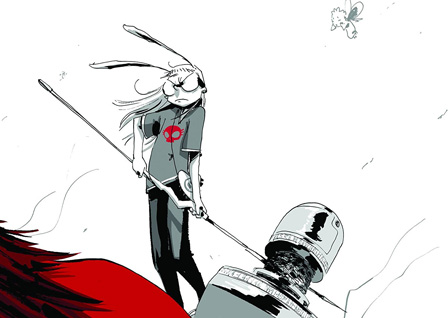
I Kill Giants
by Joe Kelly and J.M. Ken Niimura
7 vols
Image
ISBN: 1607060922 (Amazon)
I Kill Giants exploits expectations in order to tell a story that, while common, is made special by its telling. The creative team breathes a crispness into Barbara Thorson’s imaginative life that many such tales lack—and those stories, in their lack, are built of shallow caricatures that never come to life for the reader. Traveling with Barbara through the travails of her fifth grader’s existence, we are given a unique vantage into the lives and motivations of much of her supporting cast. There are still clichés that never entirely extricate themselves from the crushing weight of their familiarity (for instance the story’s bully, Taylor, is just like every other storybook bully you’ve ever encountered in bad literature), but for the most part Kelly’s script is a relief.
Accordingly, Niimura’s visual work impresses when one considers just how easy it would have been to really screw up the story by producing the wrong kind of art. When Niimura draws giants, they are impressive. When Niimura draws Barbara the giant slayer, she is awkwardly confident. When Niimura draws the intersection of fantasy and reality, we find ourselves either charmed or chilled according to Niimura’s direction.
In any case, I Kill Giants is the story of Barbara Thorson. Who kills giants. Or so she tells just about everyone.
Barbara is, sigh, precocious and outspoken. She’s a bit geek (she's into D&D and baseball history) and has a difficult homelife. Her interaction with teachers (and school psychologist as a result of her interaction with teachers) doesn’t cry out for emulation. She seems to almost purposely make enemies with those around her. And yet, despite the difficulties she presents for herself (and for the reader who wants to sympathize), she cuts figure as an able protagonist. She’s far from perfect and—for this story at least—we prefer her for it.
Amidst portents of the arrival of a grave doom, the heralding of a coming giant, Barbara has to negotiate a society with which she shares no interest. Against her wishes, the society around her makes many overtures of peace and goodwill. Some make ground while others break it. And all the while, the unseen world becomes increasingly active as the prophesied doom grows ever nearer. In the end, it’s in Barbara’s interactions with both worlds and their inevitable clash that I Kill Giants’ story takes shape.
And it was wonderful to take in.
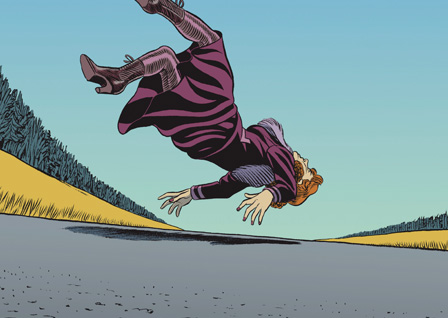
Pachyderme
by Frederik Peeters (translated by Edward Gauvin, lettered by Lizzie Kaye)
88 pages
SelfMadeHero
ISBN: 1906838607 (Amazon)
Pachyderme occupies a space similar to Kazuo Ishiguro's The Unconsoled. It's bizarre, magical, dreamlike, fuzzy. We know the scenes, the people, the places. We recognize that a story or a couple stories even are unfolding, but there's dissonance. There's a blurry bleary sort of drunkeness that sets in, making discerning the what and the wherefore difficult.
There is a mystery here to unravel and Peeters unfolds it in fits and starts across 88 pages. His art is lush and dreamy. There's intrigue afoot. And it may even be that you finish and don't know exactly what happened. So you read it again. And things clear up some. So you read it again and things clear up a little more. And maybe you understand and maybe you feel like you're now a part of something.
Or maybe you just close the book, confused and troubled, wondering what it was all for.

Age of Bronze
by Eric Shanower
4+ vols
Image
ISBN: 1582402000 (Amazon)
These books take an excruciatingly long time to come out. Volume 3B came out in 2013 and I've seen no word on a vol 3C or 4. I wouldn't be surprised if the series is never completed. That said: still worth it.
Age Of Bronze is a *comprehensive* retelling of the entire events of the Trojan War, combining the details from Homer, Virgil, and other sources. It's long, it's sprawling, it's meticulously illustrated. In this telling Shanower has opted to exclude the gods and their squabbles for what instead is the human actors beliefs about the gods. This was a narrative trick used in Wolfgang Petersen's film Troy (a movie that came out and was forgotten six years after Shanower's book first published). It's a good book and a great book and one worthy of your attention.
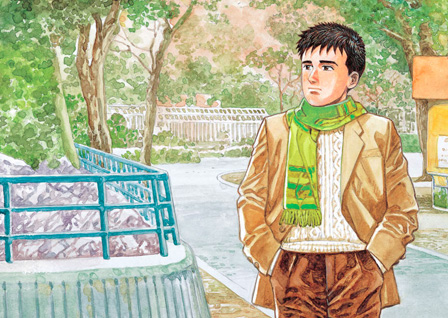
Zoo in Winter
by Taniguchi JiroKumar Sivasubramanian)
232 pages
Ponent Mon
ISBN: 1912097311 (Amazon)
A Zoo In Winter is a languid, beautiful piece from a creator who we're sad to see passed. It gives us a historical snapshot of what manga production in the ’60s was like, perhaps Taniguchi investing a bit of autobio into his fiction for the sake of verisimilitude. In any case, this is a quiet story about a somewhat timid young man, trying to find his feet and a direction for his life.
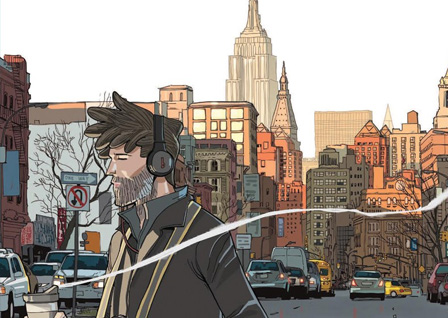
The Sound of the World by Heart
by Giacomo Bevilacqua (localized by Mike Kennedy)
192 pages
Lion Forge
ISBN: 1941302386 (Amazon)
Sam's a photographer for a boutique-published magazine in France. He's in New York recovering from a broken heart and using the opportunity to work on a special project for his editor. He will spend two months without communicating to another human (apart from morning updates to his editor via texting) in the midst of the bustling throng of the metropolis. He can eat at a particular restaurant or his apartment no more than three times in that two month period, forcing him to find ways to interact without speech. A key prop in his operating mode are huge headphones with which he can appear logistically insensible to dialogue.
This book is gorgeous, the illustrations lush and colourful. This is one of my favourite reads from 2017 so far. I can see it fitting in my end-of-year top 10 pretty easily. It's about the romance of living, the romance of a challenge, and the romance of a city. Your experience of the book will definitely be helped if you can give yourself over to the idea that New York City is a living, breathing entity suffused with a kind of special magic. I've been there once and my personal experience said the opposite, but suspending my bias for the space of this book turned it into something wonderful.
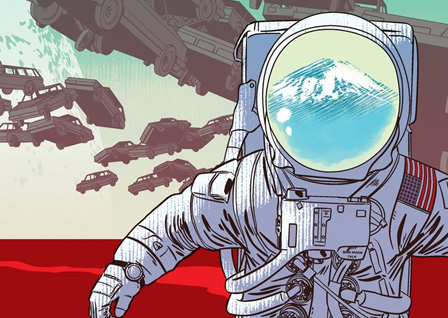
Celeste
by INJ Culbard
192 pages
SelfMadeHero
ISBN: 1906838763 (Amazon)
INJ Culbard is one of the most competent illustrators around. His style veers toward simple (a notch more detail in his faces than Stuart Immonen circa Nextwave and Moving Pictures) but he is so expressive that the simplicity suits his work and brand of dynamism. A couple of years ago American readers would probably be largely unfamiliar with him if they hadn't caught his adaptations of Doyle (Holmes), Burroughs (Martian Chronicles), and Lovecraft (Cthulhu mythos), but he's enjoyed a bit more spotlight with both the New Deadwardians and the delightful War Of The Worlds riff, Wild's End (which is actually far more interesting than War Of The Worlds).
Celeste follows three narrative threads: a young albino woman in Britain, a suicidal artist in Japan, and a middle-aged dude stuck in traffic on the 405. Then everybody on earth vanishes except these three. And the other young woman that the albino woman meets, a man stuck in another car on the 405, and the bizarre cast of yokai and other odds and ends that the Japanese man meets. All very strange, all very neat.
With Celeste, Culbard proposes an alternative to the kind of disposable stories that so much of the medium seems to be swamped in, books that can be plowed through without a single thought toward interpretation, toward meaning, toward purpose and end. The book is dreamy and trippy and a bit Twilight-Zoney. Celeste is elegant and bizarre and doesn't forthrightly open itself to the reader. It begs to be mulled. Which makes the coincidence of its lovely illustrations a special treat.
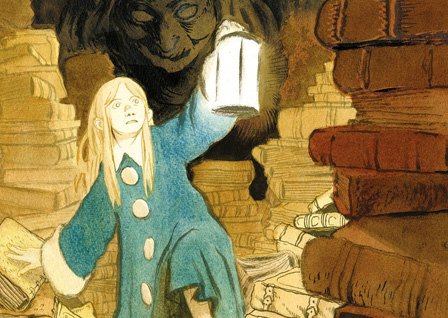
Geis: A Matter of Life and Death
by Alexis Deacon
96 pages
Nobrow
ISBN: 1910620033 (Amazon)
Here's author Alexis Deacon talking about what a geis is.
"I’d grown up with this book of Celtic mythology and folk tales and they very often used this concept of “geis.” The idea is that we all have these “geisa,” these rules we mustn’t break, but you don’t necessarily know what they are. You go to a priest or a wise woman and they would say, you must never speak to a woman wearing purple or you must never eat five peanuts consecutively or you must never jump over one black sheep and two red sheep. You go, okay, got it, no problem–but then you inevitably do all those things. There’s no way of escaping it. Often in the stories the more things they do to get away, the quicker they bring the events about. I really liked that idea of an inescapable fate. I don’t use it in exactly that way but the core is the same."
Geis a dark fantasy series. But not dark fantasy in the overly chatty, grimdark, ironically self-assured manner of we've seen become common today. This is understated and confident without being jabbery. And the art is reminiscent of Kerascoet's in Beautiful Darkness. Lovely, tricky, sinister work.
101–110111–120121–130131–140141–150
151–160161–170171–180181–190191–200

Eagle: The Making Of An Asian American President
by Kaiji Kawaguchi (translated by Carl Gustav Horn)
5 vols
Viz
ISBN: 1569314756 (Amazon)
You may call me a bit of a cynic—and you would be correct in that estimation. So what’s a guy like me doing pretty thoroughly enjoying a book like Eagle: The Making Of An Asian-American President: a book that in many ways is a celebration (or fetishization) of the American electoral process?
Honestly, part of it is novelty. The bare concept alone is interesting: 2264 pages following a candidate’s campaign from the lead-up to the Democratic National Convention all the way through to the results of the Presidential Election—but written by a Japanese creator for a Japanese audience. Seeing how an outsider views and understands and interprets something that remains mysterious even to many Americans is a treasure of cross-cultural appreciation. When he mythologizes Texas, through heavy play on ranchers and late-night T-bones as big as your head, you can see where he’s coming from. When he follows a trail into the sordid realm of labour union politics, American readers may well wonder how closely the author’s original audience could relate (what with the differences in American and Japanese business ethics and practices). And when the book’s candidate-of-choice, Kenneth Yamaoka, a third-gen Japanese-American senator (D-NY) is confronted by some of the racial difficulties that confronted Obama, you wonder how much it hurt to write those sentiments and how much author Kawaguchi was able to empathize with the more hateful elements he had to portray.
Eagle's subtitle (The Making of an Asian-American President) is interesting because you’re pretty sure that Kawaguchi is giving away the whole bag of cookies at the outset. While reading, there may be some doubt in the occasional reader as to the author’s destination, but as the story unfolds, presidential hopeful Yamaoka unveils to be perhaps the ultimate Mary Sue. There is no obstacle that he will not overcome—no scandal that will not either fade from memory instantly or turn out somehow to work in the anointed man’s favour. It might be annoying if Yamaoka was ever really the point of the book. But he’s not.
Kawaguchi’s primary interest seems almost wholly concerned with exploring what it takes to become president of the United States. And since someone is undoubtedly going to become president, for Kawaguchi’s purpose, it hardly matters who. He just needs readers to willingly tag along for the ride—most likely to see just how crazy a ride it actually is.
+ there's a lot of soap-operatic elements for those who get their thrills there.
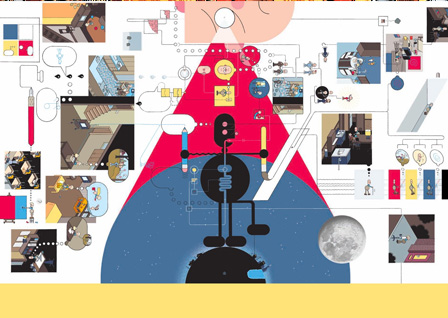
Monograph by Chris Ware
by Chris Ware, Ira Glass, Francoise Mouly, Art Spiegelman
280 pages
Rizzoli
ISBN: 0847860884 (Amazon)
Monograph is, for those with *any* interest in Chris Ware, a pretty bounty. It's his self-curated gaze into the kind of kooky, really obsessive, and ridiculously talented history of works. There's all kinds of crazy in here, but I'm mostly just glad to finally have this comic in print: 

Pantheon
by Hamish Steele
224 pages
Nobrow
ISBN: 1910620203 (Amazon)
This is off the hook bonkers. Also, pretty faithful to the Egyptian myths. Therefore, off the hook bonkers.
You know how the Greek myths are pretty nuts? Rape, incest, Zeus being a giant animorph and screwing basically anything with a hole and making demigod after demigod (cf all this). One lady he seduces by being a ridiculously charming swan.
So yeah, as nutty as Greek mythology is, it reads like Anne Of Green Gables next to the Egyptian brand of the stuff.
With that in mind, Hamish Steele's tongue-in-cheek and deeply gross comic about them is probably the perfect way to encounter and understand the Egyptian mythos. Lots of sex, lots of incest, lots of murder, and lots of other things like one god mixing his and another god's semen into a salad and feeding it to the other god and then later? that god who ate the salad? he gets pregnant and gives birth to the moon god—who had already been around for centuries at that point. ‾\_(ツ)_/‾
It's all very funny and very brightly told and is 100% not for non-debauched children.
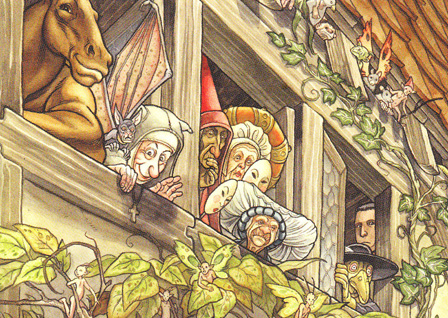
Castle Waiting
by Linda Medley
2 vols
Fantagraphics
ISBN: 1606996029 (Amazon)
In Castle Waiting, Linda Medley accomplishes something unique by proposing a medieval fantasy setting and then using it mostly to set stage for a series of character-driven episodes of people who mostly just talk about their lives. The castle at Brambly Hedge is the product of a sleeping beauty-style curse. For a hundred years, the fortress was grown up with a forest of thorns dangerous enough to end the lives of any adventurers who set out to discover the mystery of the place. Generations later, a charming prince finds his way through unscathed, wakes the princess, and the two of them leave the castle (and its servants) behind for a bright and ego-tastic future somewhere less provincial. A generation after that, the only ones left in the castle are the princess’ three handmaidens (now old), and they elect to turn the castle into a sanctuary for those in need.
That was all prologue and at the book’s real beginning, a pregnant Lady Jain arrives seeking safety inside the castle’s walls. She is fleeing from her husband lest he discover her pregnancy by another man and kill her for jealousy. Of course, all of this sounds not exactly untypical of the standard fantasy work. Maybe it’s rare to have a female protagonist open an epic adventure by running away with a baby in the belly, but everything else sounds pretty standard. It’s just that when I said this is where the book begins, it’s also pretty much where the story (in any grand sense of the term) ends.
The moment Jain enters into the Castle Waiting, all larger plot movement halts entirely and nearly all focus homes in upon the development of the relationships between Jain and those who make their home in the castle. Beyond the three handmaidens, there’s the rambunctious bearded nun, the plague-masked Doctor Fell, Sir Chess (the horse-headed knight gallant), Rackham (the werestork fashionista), simple Simon and his widowed mother, and the silent, aloof Iron Henry (the adopted son of dwarves). Each member of the community has a unique and compelling personal history and the simmering of their persons and circumstances makes for enjoyable reading.

Demon
by Jason Shiga
4 vols
First Second
ISBN: 1626724520 (Amazon)
Jason Shiga's story of immortality is kind of a diabolically clever math problem. It twists, it turns, and it constantly has me saying "Oh-ho!" as I turn the page and find everything has changed once more. Also, it's horrifically grusome and delightfully depraved, so—like—please go in eyes wide open and don't get this for your fifth grader.
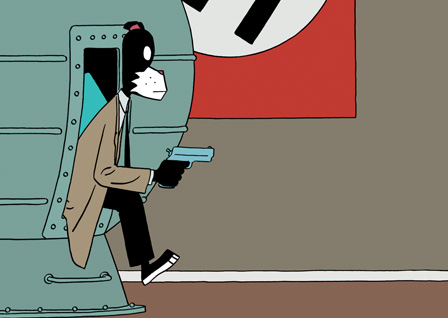
I Killed Adolf Hitler
by Jason (translated by Kim Thompson)
48 pages
Fantagraphics
ISBN: 1683960084 (Amazon)
Mononymous author Jason crafts instead a work of subtlety in which he explores themes of love and life and second chances (not disimilarly—but perhaps more on point—to how Jonathan Blow would later meditate on similar themes through his popular videogame Braid). And even more, perhaps, I Killed Adolph Hitler concerns the nature of the human creature.
The protagonist is a hitman who will kill anyone without compunction and without any more reason than a paycheck. He exists in a world in which paid assassinations are accepted, commonplace, and legal. Jason, by posing an assassin as hero sheds a different kind of light on Hitler, the protagonist’s next target—and in so doing asks interesting questions about what makes us what we are.
Also, there is time travel.

Polina
by Bastien Vivès (translated by Polly McLean)
208 pages
Random House UK
ISBN: 0224096931 (Amazon)
In a book about dancers, perhaps the one great question is how well Vivès captures the flow and sublimity of the human form and the precise gracefulness required of it in the dance. I can’t say whether or not his work comes easily, but because Vivès conveys his subjects’ lithe and supple movement so naturally, his illustrations appear effortless. It helps that his style here is closer to impressionistic than realist; that allows him to focus on exhibiting his intent rather than working counter to purpose by getting lost in details. And while Vivès will occasionally fill his backgrounds with intricated set designs, he still more often provides either no background at all or only the merest fragile skeleton of a setting for his characters. This permits his dancers to float in negative space, buoyed in an elegant frame of nothingness. They are the subjects and they communicate with their bodies even apart from the context of the spaces they would actually be inhabiting. It’s a powerful technique and does much to lend weight to the presence of his actors.
Vivès’ story is lively and important—in the sense that any time we follow a child through to adulthood, the movements that carry her along must be of great moment. And nearly every page of Polina works to this end. Every moment is of moment. Every moment is a work of art.
At about the halfway point a friend relates a maxim to Polina, a little something that carries him through: “Dance is art. There is no opponent and no partner.” Polina, as Vivès presents her, is herself art. She is in every instance an artistic effort, a creative impulse intended to convey a creative impulse. Her carriage is practiced, her posture intentional. Bojinsky, the imposing figure who instructs Polina from her childhood, reminds that “The audience must see nothing except the emotion you are conveying. If you don’t show them grace and lightness, they will only see effort and strain.” Of her own intention or merely by Vivès fateful hand, Polina’s every appearance is an exploration of her teacher’s admonition. Vivès is intent on pushing tremendous readability into every panel. We know Polina’s thoughts by her look, by her face, by the way her body hangs in the space she occupies. We know her relationship to those around her by Vivès’ use of positioning and body language.
Polina is a book about perception and appearance. The world as it is and the world as we see it and the world as we present it. Polina is about beauty and distress. Polina investigates, by charting a small dancer’s path to womanhood, the way the choices we make inform not only our circumstances but the manner in which we see those circumstances. It’s rare to find a tightly woven narrative that simultaneously gives its story the chance to breathe, but Polina does that. Nothing, not even the emptiness, feels as excess. All of it is present for its purpose, but Polina introduces us to the idea that being governed by a fate and destiny (as all stories are) doesn’t have to feel constrictive.
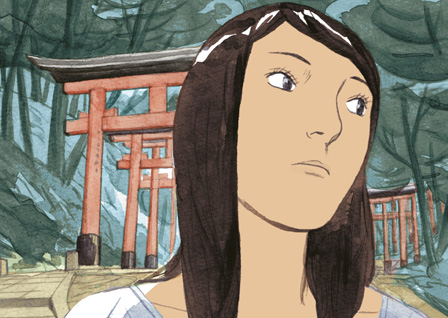
Just So Happens
by Fumio Obata
160 pages
Harry N. Abrams
ISBN: 1419715968 (Amazon)
Obata pens a story about a young woman who really has no home. She's long expatriated from Japan to the UK, but is still of course Japanese and friends and co-workers still interpret her social differences as being directly tied to her national origin. Neither is she at home with the country she left. Just So Happens has the woman returning to Japan for a funeral and investigating her self and perceptions. It's a quiet work—and rather lovely, featuring some of the most beautiful art.
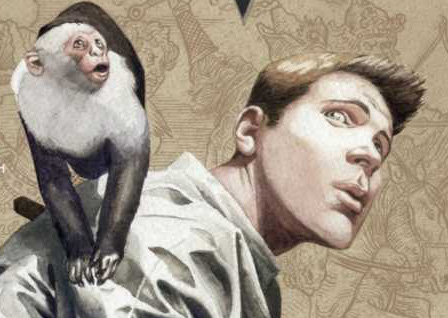
Y: The Last Man
by Brian K. Vaughan and Pia Guerra (inked by José Marzán, coloured by Pamela Rambo, lettered by Clem Robins)
10 vols
Vertigo
ISBN: 140125151X (Amazon)
This is another one I haven't read in a very long time, but in my mind's eye, it's the work of Vaughan's that best withstands and capitalizes on his particular brand of dated, hip-to-the-moment pattered dialogue. Yorick is funny and obnoxious and you kind of hate him but it works.

Shoplifter
by Michael Cho
96 pages
Pantheon
ISBN: 030791173X (Amazon)
A woman in advertising who wonders if she should be in advertising lives her life, browses dating profiles, and suffers the kind of lack of extroversion that lets friends score with guys she's eyeing. She's an average Joe living an unremarkable life but for her one exertion of power: she shoplifts an almost inconsequential item from the local convenience store whenever she stops in. It gives her verve and spark and life, she thinks. Shoplifter is a week or two of her story and it is told with excellent precision and with gorgeous illustration technique.
101–110111–120121–130131–140141–150
151–160161–170171–180181–190191–200
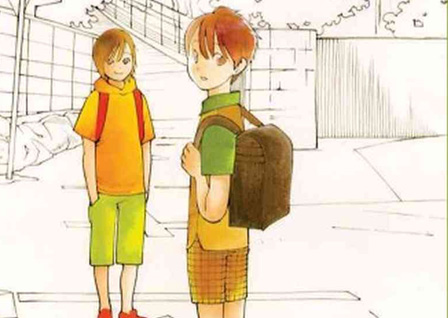
Wandering Son
by Shimura Takako (translated by Matt Thorn)
8 vols
Fantagraphics
ISBN: 1606994166 (Amazon)
Story time. Late '80s. In a gathering of high school kids for some event or other, there was a game in which people would have to perform some stunt of the leader’s choosing. One of them was to speak in a gay lisp. Five-sixths of the guys involved wouldn’t participate—not because it was insensitive or anything—but because it was too gross. A friend of mine took a trip to Africa and this tribe’s chief took his hand, wanting to show him the village. My friend shook off that man’s hand. Fifteen years later he, a pastor, is still pretty pleased with that decision and occasionally (from what I hear) brings it up in sermons. In high school, at a school in the center of the second gayest town (per capita at the time) in California, there was a boy who tried out for the cheerleading squad. He was immediately deemed gay (and therefore gross). I don’t even know if he ever wore a cheer skirt or if he wanted to. And of course that wouldn’t have had anything to do with his sexual preferences—we wouldn’t have known that—but at least within the scope of our warped cultural pericope, that would have been justification enough for our prejudice. Because at that time, gayness was still considered something kind of a little bit awful. The mere hint of peculiarity in terms of sex or gender presumptions was enough to send us all into a whirlwind of confusion and antipathy.
I’m not sure that having read Wandering Son would have helped, but it very well may have. Anything that humanizes the targets of othering is worthwhile because empathizing with those who are Not You and Not Like You is essential to loving them as you do yourself. And above everything else that it does so well, Wandering Son humanizes its characters—regardless of how much they deviate from the cultural norms their societies dictate.
(Which should be easy, right? Because these characters are human. Really, we shouldn’t even need a book to make the effort, but even my own very narrow personal history demonstrates with force that we do need books to make the effort.)
On the cusp of junior high, Shuichi and Yoshino struggle with gender expression. Shuichi, a boy, finds himself increasingly wishing to dress as a girl, while Yoshino, a tomboy who already dresses in a nonfeminine manner, pushes against her culture’s proposal that she ought to be more ladylike. While Shuichi himself thus far in the series only expresses through transvestitism and remains heterosexual (eventually pursuing a girlfriend), the book eventually and additionally treats discussion of transsexuality, gender identity, and what the experience of coming of age in such turmoil might entail.
When I first approached Wandering Son I was concerned that, like so many works that have lessons to impart, it would come off as didactic and proselytizing. Instead, we have this warm-hearted, gentle story about a collection of kids growing up. Wandering Son doesn’t lay out any argument for the humanity of its characters who diverge from social expectation. It doesn’t need to.

Rachel Rising
by Terry Moore
840 pages
Abstract Studio
ISBN: 1892597624 (Amazon)
Terry Moore's books are all just a lot of fun, but Rachel Rising is my favourite. It's got horror, gallows humour, religion, camaraderie, and more. It's a wild ride and I didn't really have any idea where it would end up and was perfectly pleased to sit back and enjoy while we got there.

Panther
by Brecht Evens (translated by Michele Hutchison and Laura Watkinson)
120 pages
Drawn and Quarterly
ISBN: 1770462260 (Amazon)
Panther is a weird sort of recommendation because I'm not sure I actually liked it much. It's dark and a little abstruse (abstruse enough that I've read a lot of people misinterpret Panther to be a twisted representation of a sexually abusive father—which is not a spoiler because it's not a very well-proposed interpretation despite being very common). It's hard to know what exactly happened unless you're willing to just take everything literally. And that Panther's dialogue is all in green cursive makes it actually annoying to read, because cursive is actually annoying to read.
On the other hand, it's fiercely imaginative and beautifully drawn. Brecht's art is lush and fascinating. Panther changes his clothing and form in every panel as he engages in wordplay and play play with Christine. The book seems ripe for thoughtful interpretation (though I'm not certain Evans actually gives us enough hooks by which we might come to realistically grasp what's going on).
Panther is a book to be taken in and considered. Even if you don't end up enjoying it (it made me uncomfortable, rightly).
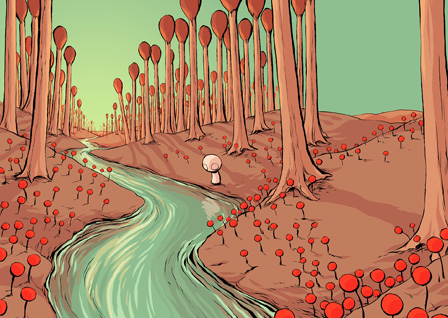
Rice Boy
by Evan Dahm
460 pages
Iron Circus
ISBN: 1945820101 (Amazon)
Rice Boy is Evan Dahm's first dive into his world of Overside, and of the three existing books is I believe chronologically the last. That it's an early work does show and the book appears rather primitive next to the visual wealth of something like Vattu. Still, its a solid work and devastatingly imaginative - like all of Dahm's Overside stories.
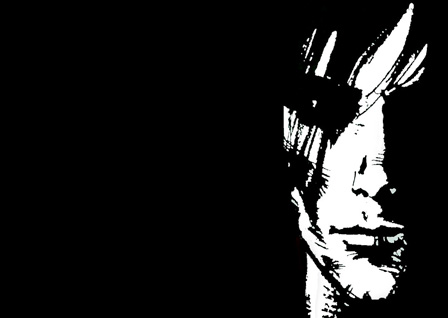
The Sandman
by Neil Gaiman, et al
10 vols
Vertigo
ISBN: 1401284779 (Amazon)
Reading Neil Gaiman’s (sprawling) work, Sandman—the work that bought him fame in the beginning—from beginning to end, I was struck by what may be a weakness on my own part. Gaiman, I believe, is at his resolute best with the shorter narrative. The sparring match, the experiment. Sandman is a curious work because it is itself a grand, arcing story forged of numerous arcs that develop Gaiman’s narrative direction but it is also fraught with individual, self-contained, singular episodes whose purpose seems merely to add flavour to the entire literary meal. And it is in the space of these singular episodes—which never last longer than a chapter’s breadth—that Gaiman proves his genius. And it is in the longer, more ambitious pieces of Gaiman’s wonderful tale that his mastery seems to falter.
To be plain, when it comes to Sandman, I prefer Gaiman’s sparring to his real combat. And this may reflect more on me than on Gaiman’s text here.
In any case, while Sandman contains some of the most sublime, interesting, and humourous acts of narrative whimsy I’ve encountered, the whole suffers by the comparison. It’s not bad by any stretch; the work is still engaging and well-conceived. It just lacks the beauty of some of its contained stories.* Some of the longer arcs, even, are wonderfully told. But as a whole I don’t believe that Sandman is quite as good as some of its parts.
Sandman explores the question of what might happen when one of the eternal forces that govern our world begins to change. The Lord Dream, Morpheus, one of the seven Endless, and brother to Death, Despair, and Destiny (among others), is our protagonist and Gaiman begins the journey with his capture at the hands of some overly ambitious human mystics. This seems to be the event that sets everything along its paces, but Gaiman is more circumspect than to toy with such obviousness. Like in most things, final outcomes (as well as those in between) result from innumerable influences, the vast majority of which seem mere inconsequentialities. That Gaiman can pull so many of these disparate threads together pays homage to his stature as an author.
And despite enjoying certain portions of the series so much more than others, it cannot be said that Gaiman’s work here is anything other than tremendous. Sandman receives nothing less than a strong recommendation. It is not Gaiman’s best work, but it is still good enough that it is better than much of what is available and well-regarded. If a person lives to life’s end and chooses not to experience Sandman, I can say with confidence that they have chosen to actively impoverish their life.
*note: for those who’ve read the series, the short episodes to which I refer to as being so wonderful include the following: “The Sound of Her Wings,” “Men of Good Fortune,” “A Dream of a Thousand Cats,” “A Midsummer Night’s Dream,” “The Hunt,” “Three Septembers and a January,” “The Parliament of Rooks,” “Ramadan,” and the tales told in the Inn, World’s End.
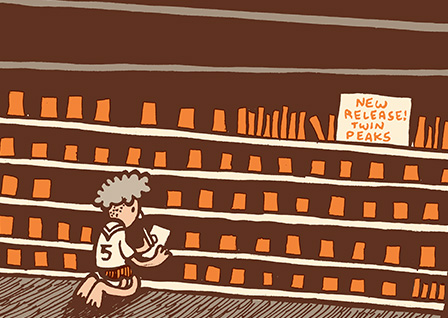
Toormina Video
by Pat Grant
webcomic
Self-published
Read here
Toormina Video is Pat Grant's reflection on his childhood and how his father would set him aside to drink—and then, about Pat's own responsibilities as a grown up. In a way, he does the same thing with Blue, using memory to critique the present.
It's an affecting work and highly recommended.

Brass Sun: The Wheel of Worlds
by Ian Edginton and I.N.J. Culbard
208 pages
2000 AD
ISBN: 1781082847 (Amazon)
This is an awesome sci fi series. Basically, you start on this snow planet and this girl's heretic grandfather gives her secret information about the world before allowing himself to be martyred, paving the way for her to enter a secret door in this great spire.
Turns out the spire is the great arm that her world spins on and the whole thing is part of this enormous clockwork solar system. The way you travel through from planet to planet is via a rail system, only that's been on lockdown for the past 2000 years since the great worlds' war.
Anyway, we join rabid, fierce, determined grandaughter Wren and her new companion, the monkish railway kid Conductor Seventeen as they travel the worlds on a quest to stop the sun from burning out.
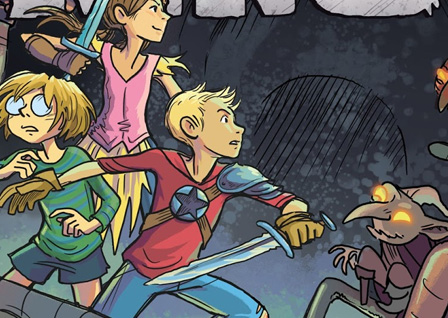
Mighty Jack
by Ben Hatke (coloured by Hilary Sycamore)
2 vols
First Second
ISBN: 1626722641 (Amazon)
One of my favourite books to recommend younger readers (from Kindergarten to about fourth or fifth grade) is Ben Hatke's Zita the Space Girl. It's a buoyant story about a plucky, wonderful, and sometimes not very kind little girl who gets sucked into a tremendous space adventure. Hatke wrapped the trilogy a few years back and I've been waiting for his next major work since then. He's switched things up a bit, doing a couple picture books and a shorter graphic novel (Little Robot) that's probably aimed at readers a little younger than Zita was. This year though, he brought us Mighty Jack, a sort of riff on Jack And The Bean Stalk. And you know what? It's better than Zita.
Mighty Jack proves that practice can make you better at what you do. Really, we already saw this at work with Hatke, since each volume of Zita was more accomplished than the one before. Mighty Jack is well-paced and more lithe. It's a fun and dangerous adventure, aimed probably at the same range as Zita, maybe a touch older. My only regret is that this first vol ends on a cliffhanger when all I really want is to plow through to the end. And yeah, I say the book is aimed at young readers, but despite the fact that my kids love it, I'm the one who is salivating to find out What Happens Next.

Inside Mari
by Shuzo Oshimi
192 pages
DENPA
ISBN: 1634429001 (Amazon)
On the heels of Flowers of Evil, Oshimi crafts a weird story about a post-highschool loser who somehow has his mind transferred into the head of the pretty girl he's been stalking. Or is that what happened? After all, his old body seems to be doing just fine without him. In any case, Mari or the boy who's inhabiting her has to learn how to behave all over again. And whatever Mari's life used to be, there are changes afoot. Inside Mari isn't quite as ambitious as Flowers Of Evil, but it's still worthwhile and continues to prove Oshimi a creator worth paying attention to. As with Flowers Of Evil, he continues to play with common tropes and turn them in unexpected ways.
One thing I appreciated was how deftly Oshimi conveys the terror and discomfort of waking up in someone else's body.

A Thousand Colored Castles
by Gareth Brookes
208 pages
Penn State University
ISBN: 0271079274 (Amazon)
Myriam is seeing things that defy believability, but really of course she would. Castles pouring from the sink, girls in motorcycle helmets melting into the ceiling, men with ladders for heads, a naked boy next-door playing with exotic parrots. The usual for the British suburbs, of course. But something more is going on. In Myriam's mind or in reality, it hardly matters because she is going to do something about it—just as soon as she can figure which of her 18 door handles is the one that will open the door.
101–110111–120121–130131–140141–150
151–160161–170171–180181–190191–200
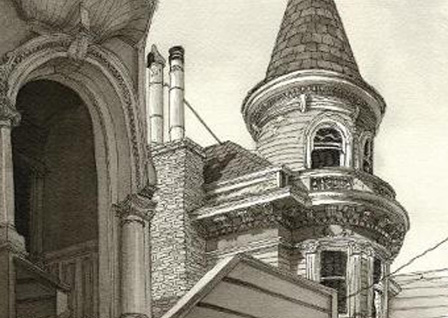
Everything Is Its Own Reward
by Paul Madonna
240 pages
City Lights
ISBN: 0872865150 (Amazon)
This is a second collection of Madonna's San Francisco-centric strip All Over Coffee and the illustrations are gorgeous, pen and ink washes with occasional rare bursts of colour. Madonna's writing is usually spare and usually intriguing. Sometimes he'll offer a trite bon mot, sometimes a wry anecdote (memoir or fiction, who can tell), other times he'll just let a pile of his words sit their confronting you.
This is not so much a book to burn through - as there's no narrative harness to keep your attention. Each page is an installment of Madonna's weekly strip and each are to be taken on their own, sustenance enough for several days at least before picking up the next. Though if you want to burn through them, there's no one stopping you - we're all adults here. It's just that doing so would probably lose some of the grandeur, some of the flavour, and some of the meaning.
This is, probably, the ideal coffee table book of comics. The dimensions are large enough, 12"x9", and the book is perfect for a guest to flip open to a random page while they're waiting for you to finish pooping or making tea and come away with a neat brief experience. At the very least, go to a bookstore, find this, and flip through it. Beautiful work.
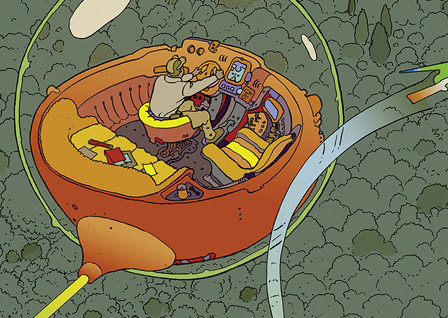
The World of Edena
by Moebius (lettering by Adam Pruett)
360 pages
Dark Horse
ISBN: 1506702163 (Amazon)
Whenever you get a chance to read Moebius unshackled from Jodorowsky's janky writing, you take it. With certainty, the reason to delve into The World Of Edena is still Moebius' art, but at least with Jodorowsky out of the picture you don't have to wince with nearly every page of dialogue. The ideas Edena explores are interesting, but won't blow your mind. Regardless, Moebius creates some visuals that will knock our socks to kindom come.

Sanctuary
by Sho Fumimura and Ryoichi Ikegami (translated by Matt Thorn, lettered by Mary Kelleher)
9 vols
Viz
ISBN: 0929279972 (Amazon)
Sanctuary made its way to the US in that same wave of Viz releases that brought us Eagle and Banana Fish, exciting books aimed at a grown-up audience. Sanctuary is absolutely thrilling as it tracks very bad people play the political machinations game against worse people. This is yakuza vs yakuza vs politicians vs politicians. Murder, kidnapping, rape, mayhem, violence, assassination, war, assault, and a general bad attitude pervades the book. These aren't good people but they're operating on a kind of ends-justifying-means mentality that, if you can suspend your moral self for the space of the read, propels a pretty thrilling story.

Generations
by Flavia Biondi (translated by Carla Ronaclli Di Motorio)
144 pages
Lion Forge
ISBN: 1941302505 (Amazon)
"I thanked all my mistakes and my cowardly choices. If it hadn't been for them, I wouldn't understand."
Generations is about second chances. Generations is about growing up. Generations is about other peoples shoes. Genreations is about family and what family means and what family does and how family will make you the strongest person in the world if you let it—and sometimes maybe if you don't.
Genreations is about Teo, who ran away to Milan in the face of his father's unhappiness when Teo comes out to him. Generations is about Teo, who comes back home to the country, living with his grandmother and three aunts and his pregnant cousin while he tries to figure out whether to and how to patch things up with his father. Generations is about Teo, who is trying to not be a great big baby about life for the first time in his life, only he needs help but isn't that good at asking for help.
When I first was reading Generations, I thought it was fine. A good book but not a great book. It hit a lot of notes I'd seen before. But then, somehow in the final twenty pages or so, in the book's closing sort of an essay, I was swept up into this roiling torrent of emotion. I found myself deeply and satisfyingly moved. It's not a feeling that hits me often enough while reading and for that I'm rewarding Generations as best I know how. This book will remain a treasure to me.
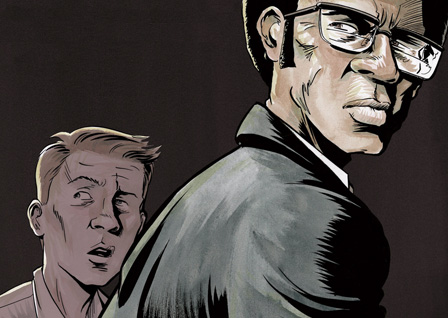
The Silence of Our Friends
by Mark Long, Jim Demonakos, Nate Powell
208 pages
Square Fish
ISBN: 1250164982 (Amazon)
A lot of you are familiar with Nate Powell from his work illustrating Rep. John Lewis' memoir March. He does powerful work and it's a powerful story, but March isn't the first time he's illustrated stories from the Civil Rights Movement. A few years after Powell's seminal work Swallow Me Whole and one year after Any Empire, Powell illustrated The Silence Of Our Friends, Mark Long's story about his father's part in 1967 Houston and the civil rights turmoil at the time.
Jack Long is a white television journalist and his station's "race reporter." Jack is sympathetic to the black cause and makes friends with Larry Thompson, a leader with SNCC (readers of March will be familiar with the group). The scope of the book moves from the framing of Samuel Otis for murder through the TSU Five and concludes with the death of King.
While March is maybe more overtly powerful, The Silence Of Our Friends is perhaps more intimate, focusing much of its space on the perspective of both Jack and Larry's children and how they absorb and interact with the world their parents are giving them.
Some might question making the foremost protagonist of a book about the Civil Rights Movement a white man, but the autobiographical context I think absolves the book of what might be more questionable in a work of pure fiction. Writer Mark poses an intimate portrait of his own father and a vaguely less intimate one of Larry Thompson—and he does spend a fair amount of time with the camera on his young self.
Where the book really shines is in Powell's organic brushwork. These pages are beautiful and lively—and it's absolutely no wonder that he got tapped to draw March on the strength of his work here.

Ducks
by Kate Beaton
webcomic
Self-published
Read here
While Kate Beaton is largely known for her very funny comics about literature and history (notably in her collections Hark A Vagrant and Step Aside Pops) and is loved for her humourous comics about visiting her family over the holidays, my favourite of her works is Ducks, a short series that explores Beaton's time working in the Canadian oilsands (by every account I've read and from friends who've worked there, a terrible place).
The work balances really well the largescale environmental issue with the individual personal dramas that swallow everyone regardless of their exterior contexts.
It will probably take you ten minutes to read. Maybe less. It's worth that time.
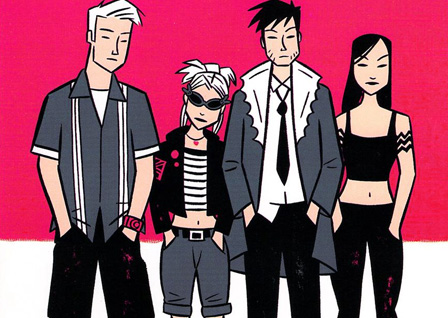
Hopeless Savages
by Jen Van Meter, Christine Norrie, Bryan Lee O'Malley, et al
4 vols
Oni Press
ISBN: 1934964484 (Amazon)
Dirk Hopeless and Nikki Savage married and hyphenated. Dirk and Nikki are grown-up-and-settled-down former punk rock legends. Or maybe they’re current legends and former stars. Something like that. In any case, they're middle aged with four Hopeless-Savage offspring (from youngest to oldest), Skank Zero, Twitch Strummer, Arsenal Fierce, and Rat Bastard (all their real names!). The kids ages range from highschool-aged Skank Zero to well-into adulthood Rat Bastard.
Over the course of the series, Van Meter makes marked use of flashback. Every chapter contains a several-page flashback (drawn by a secondary artist so that it’s easily discernible from the main story). These flashbacks not only embellish the current storyline, giving motive to otherwise unexplainable actions, but they serve to give the series a grounding in history. It’s one thing for us to hear that Nikki Savage used to be a wild thing on stage but another to actually see what she was like back then. It’s one thing to know that Rat left the family because of a girl but another to see it play out. These bits and pieces lend credibility to the work. Kind of like how Tolkien’s inclusion of songs and legends helps the realization of his LOTR world.
One of the recurrent themes of Hopeless Savages is family and its essentiality. With the exception of Zero (who is, I believe, a junior in high school at the start of the series), all of Dirk and Nikki’s children are grown and leading their own lives (and generally pretty successfully). Dirk and Nikki are on the verge of being empty-nesters. But far from being on the cusp of a certain lonely liberation, their family is still very close and they spend more time together than many families that share a single roof. For all of the Hopeless-Savage’s anarchic roots, the governance of valuing family rules each of their hearts almost completely. It’s a joy to see—and as a father to young children, I hope to see my life somewhat a mirror to theirs twenty years from now.
Hopeless Savages is an enjoyable series and four volumes is tragically too few for characters who deserve far more. I very much hope Van Meter will eventually return to this creative corner and round out the cast a bit more. And then more. And then more.
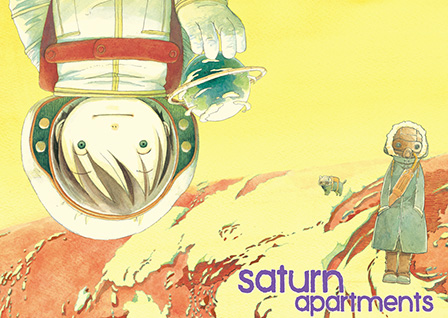
Saturn Apartments
by Hisae Iwaoka (translated by Matt Thorn and Tomo Kimura, lettered by Eric Erbes)
7 vols
Viz
ISBN: 1421533642 (Amazon)
In Saturn Apartments, the earth has been abandoned for decades, existing now as a global nature preserve. Whether due war or pollution or a humanitarian attempt at a Babel-like house to scrape the heavens, the reason for the current state of the earth is, seemingly, apart from the interests of the series. All that matters is that the earth has been abandoned and all of the remnant humanity dwells on a great ring encircling the earth in low orbit, pretty much smack in the middle of the stratosphere. While never explicitly referred to within the text as the Saturn Apartments, the ring does make the earth resemble Saturn a bit. Or at least maybe Uranus. The ring itself is divided into three strata: upper, middle, and lower sections. The middle section is devoted to public works such as schools, parks, government, and scientific endeavors. Elites live in the upper reaches of the ring while everyone else is shuffled into the lower division.
Saturn Apartments’ primary narrative conceit is that somebody’s got to wash all those windows. Dwellings that sit on the epidermis of the ring have windows that look out into the reaches of space (everyone else has to content themselves with artificial light and skies) and, even in space, a film of dust gradually accumulates. Those with the money to do so hire window washers to help them keep their perspicuity. As washers require space suits, months of training, and hours to pressurize in order to clean windows, it’s rare that anyone from the lower levels has the opportunity to clean their windows; ironically, it’s these grime-caked windows of the lower levels that face the earth and the spectacular view that such portals could provide.
Iwaoka’s protagonist is Mitsu (the orphaned son of Aki, a washer who fell to earth in a window-washing accident five years earlier). Mitsu has just graduated high school and is accepted into his father’s guild, where he encounters all of Aki’s old friends and co-workers. Mitsu is both diligent and distracted, the presence of a hard-working father he barely knew weighing heavily on his life and direction. He’s a little bit lost, a little bit unformed, and pretty uncertain about his purpose in things. He’s eager to find and prove his place within the guild but until he discovers himself for who he is, he’ll never be able to confidently chart his own personal destiny.
It's a wonderful series that absents itself of all pretensions, simply presenting a warm-hearted, optimistic tale of how a boy made charming wholly on the strength of his determination to do a job well could interact with his severely broken society for its ultimate good. Saturn Apartments is rather a call-to-arms for sincerity, diligence, and dreams—yet it never felt (to me at least) naive or didactic or saccharine. One of my favourite small books over the past several years.
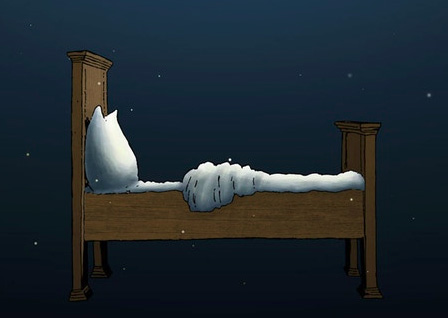
Little Nemo: Dream Another Dream
by Gerhard, Mike Allred, Charles Vess
144 pages
Locust Moon
ISBN: 0989907694 (Amazon)
This is a huge book at 16" x 21". It's a modern-day tribute to the whimsical work of Winsor McCay. There are a lot of different artists on deck and so a lot of different styles employed. It's wild and wonderful - especially for fans of Little Nemo.
The creators involved seem pretty variously familiar with Little Nemo. Some might have well-versed experience with the strip while others seem like they might have only read the first ten (because they don't show much familiarity with character development).
Because this is a book paying homage to a comic strip that's now over a century old, many of the contributors engage in some social critique of McKay's use of the common racially charged tropes when it comes to characters like the spear-carrying dark-skinned tribal named Impie (like critique is applied to cranky Irishman, Flip). Some of the critique is insightful, while some seems more in place to let the reader know that a particular creator does not wish to be complicit in the troublesome expressions of several generations passed. There's also the occasional investigation of Nemo's early-series quest object: appearing before the Princess, daughter of Morpheus.
Like Little Nemo itself (also best appreciated in one of the luscious oversize volumes available), the best experience is not to burn through the pages but rather to take a strip or two a week. Enjoy it for its momentousness.
Dream Another Dream makes for a gorgeous coffee table book. It's a wonderful conversation starter and a great way for guests to occupy themselves for a few spare minutes.
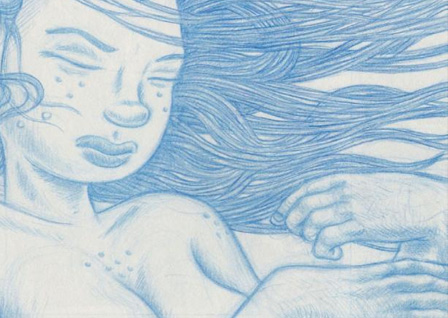
Nod Away
by Joshua Cotter
230 pages
Fantagraphics
ISBN: 1606999117 (Amazon)
Nod Away is part 1 (of 7) of a series that begins by exploring a world where (nearly) everyone is networked to a internet accessible directly by the mind (no physical or visual interface). There's a space station, terrorists, activists, ennui, and some dude wandering the wastes who hasn't been explained yet.
The art is neat, the story seems relevant to many people's near-future concerns, and there's plenty of mystery about where this whole thing is going. I don't typically recommend a series based off a first volume because there's a ton of risk there, but this has a strong vision, so I think some of you might like to get in on the ground floor.
101–110111–120121–130131–140141–150
151–160161–170171–180181–190191–200

I'm Not Here
by GG
104 pages
Koyama
ISBN: 1927668492 (Amazon)
It took me a couple reads to get anything approaching a handle on I'm Not Here. Part of it is that I'm too much a square to "get" the indie scene that makes the indie scene look like the mainstream scene, but really (at least in this case) I just need a hook on which to hang my hat. I was thinking about I'm Not Here and why I wasn't quite grokking it despite its lovely illustrations. Finally, I realized that I was somewhat reading a graphic novel version of what a Murakami short story might look like. There are differences for sure, but that was my doorway into the story and that helped me become more comfortable with the mysteries and magics at play in GG's story. It is, I think, somewhat an exploration of a woman's relationships with her family (made frail through time's march), with her environment, with her history, and with her self.
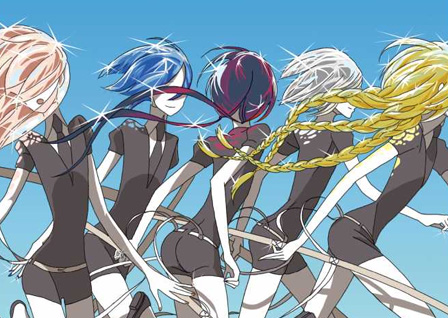
Land of the Lustrous
by Haruko Ichikawa
7+ vols
Kodansha
ISBN: 1632364972 (Amazon)
Land Of The Lustrous is kind of amazing in how rapidly a story about incalcitrant, functionally immortal beings evolves and changes. Some of these characters are 700 years old and harder than steel, but the youngest of their group breaks and remolds and grows and shifts in both form and personality and motivation. She doesn't just have a character arc; it's more like a character squiggle.
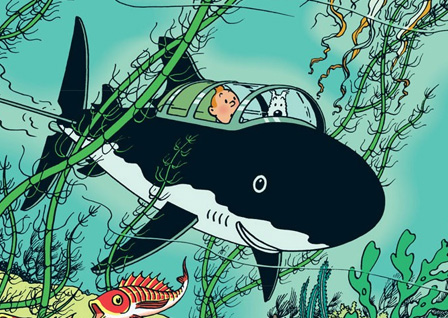
The Adventures Of Tintin
Herge
24 vols
Little, Brown
ISBN: 0316006688 (Amazon)
Tintin is one of those straight-ahead classics that's just easy (especially for younger readers) to get swept up in. His adventures are wild and dangerous and exotic (especially for a late-mid-century reader before the internet shrunk the world forever). Tintin travels to all the corners of the world (sometimes even traipsing off-world) and gets into scrapes everywhere. Herge does suffer, as do most of his white contemporaries, with that kind of cozy paternalistic racism and orientalism that mars so much of the work from the era. It's a good lesson for readers in that it shows otherwise intelligent people can be easily blinded by their priveleges and priors.

Blue
Pat Grant
96 pages
Top Shelf
ISBN: 160309153X (Amazon)
In Blue, Pat Grant allows the grown-up version of a surf rat named Christian to narrate the changes that have taken place over the fifteen years since a new kind of foreigner began trickling onto Northern Australian shores. It’s fascinating because Grant allows his protagonist to hold all manner of distasteful fears and opinions while simultaneously vindicating some of his protagonist’s views. It’s a delicate procedure, but I think it pays off. Greg Burgas was less sure and found Grant’s unwillingness to condemn his lead’s prejudices to make uncomfortable reading. I can see where Burgas is coming from, but I think that Grant’s book gives the reader an opportunity to explore not just Christian’s prejudices but their own as well.
In extended, almost book-length flashback (like Stand By Me in several ways), Grant introduces the book’s principal foreigners as blue-skinned, four-legged, alien-looking beings who propagate graffiti at alarming rates, have a different fashion sense, and are careless with their litter. Between the time of their arrival and the setting of Christian’s narration, the town of Bolton goes from a thriving town and 1989 Tidytown Winner to a broken down village entirely covered by graffiti and dominated by noodle shops, a favourite cultural food of the blue people (who are now the majority population).
And here’s the trick Grant plays on readers. In Christian’s view (and quite possibly from the view of Grant’s readers), the shift from Tidytown to Graffititown is a deeply negative experience—and proof that unchecked immigration is Bad. Where Blue offers the reader the opportunity to self-examine is in considering the same world from the vantage of the blue people. Grant is careful to humanize the foreigners through cues rooted even within Christian’s prejudiced narrative. We see the blue people’s attempts at assimilation and the loneliness in an orphaned blue child. Grant gives the blue people a mortality that mirrors the mortality of the native white Australian (we see a description of a dead body visualized as a non-foreigner, but when it is discovered to be a foreigner, it looks the same but is coloured blue).
So then, the question: in the view of the blue people, is the town better or worse than it was fifteen years ago? Plausibly, the blue people would say it’s better, more comfortable, and more in line with their cultural tastes. So who then is to say that the Tidytown version of Bolton was the better iteration? Whose culture gets to play arbiter? Grant makes it clear that adding new individuals to a society will alter culture within that society and that those comfortable within a society are going to suffer some measure of change.

Emma
Kaoru Mori (translated by Sheldon Drzka, lettered by Abagail Blackman)
5 vols
Yen Press
ISBN: 0316302236 (Amazon)
Emma is chiefly the story of Emma and William, an orphaned household maid and the son of the monied class. This is a romance and we see them meet-cute, fall for each other in that stereotypically understated Victorian way, encounter difficulties due their class distinctions, and finally resolve their relationship. It’s a lovely little story.
As Emma is the story of two principles, Mori leaves every other story untold. While William and Emma’s story finds its resolution, a reader could easily become frustrated with the many loose ends Mori leaves untied in her supporting characters’ regard. Personally, I found this abandonment of other characters charming and felt their untold stories just added to the book’s wonder. Because of Mori’s reluctance to end all stories with the conclusion of Emma and William’s story, she keeps Emma from being yet one more example of contrived romance.
Mori’s storytelling is impressive. The weight of her line perfectly suits her subject matter; it’s crisp and confident. She excels at choosing setting, pace, and moment, giving her characters the opportunity to reflect on actions, words, or thoughts from prior panels and pages. As well, Mori includes any number of silent scenes, allowing the reader to pause and take in the full scope of what is occurring within the more introspective parts of her characters stories. Keeping the reader involved, Mori uses a number of visual devices, requiring one to pay attention to camera angles and character details. The storytelling occurs as much through visual relief as it does through verbal narrative and dialogue.

Pink
Kyoko Okazaki
256 pages
Vertical
ISBN: 1939130123 (Amazon)
Yumi is a call-girl in the evenings, raking in dough at a high risk in order to feed her pet crocodile (whom she occasionally fears may end up eating her). Haru is observing the human condition while playing gigolo to Yumi's step-mom. It's almost a savage rebuild of Breakfast At Tiffany's—minus a yellow-faced Mickey Rooney but plus a crocodile representing the relentless hunger of the capitalist paradigm. Pink is comically cynical and refreshingly blunt. Love, sex, capitalism, avaraice, misogyny, and misanthropy. One could be tempted to see Pink as one more brutal evisceration of the contemporary materialist mode, but the book's humnour and joie de vivre do a good job of either masking the effort or, at the least, spritzing a good amount of perfume over the whole affair.
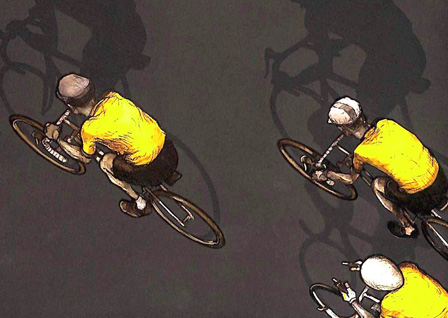
Legends of the Tour
Jan Cleijne
160 pages
Head of Zeus
ISBN: 178185999X (Amazon)
I'm not into spectating sports. I never have been. I don't care to watch others physically excel. Once upon a time, before age and injury and surgeries and the frailty of the race overtook me, I did like to participate in athletic endeavors myself. But I could never sit back and enjoy the hard work and skill of others. And even when I was athletic and fast and well-balanced, I still didn't ever care for racing bicycles.
So when I approached Legends of the Tour, a book telling stories from the history of the Tour de France, with some admixture of apathy and antipathy, it should underscore just how good the book is when I say that it absolutely enchanted me. I couldn't put the book down. It has no central character apart from perhaps the race itself, and yet it is a gripping experience of these dudes' weird love for riding bikes really fast for a long time. Up and down mountains. In terrible weather. Through the night. At cost to their health and sometimes their lives.
And it's beautifully illustrated.
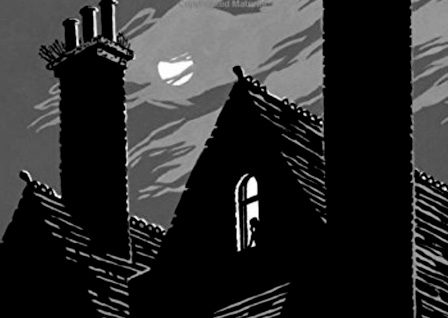
Thornhill
Pam Smy
544 pages
Roaring Brook
ISBN: 162672654X (Amazon)
More and more often over the last few years, comics creators seem to be willing to experiment blending straight prose with comics. There have been some successes like Russian Olive To Red King and Nao Of Brown and Equinoxes. And some less successful ones like A.D. After Death where I really just wanted the prose parts to be in comics form. Thornhill is one of those that gets the mix right, and maybe wildly right. Thornhill will remind acquainted readers of Ruth Ozeki's novel from a few years back, Tale For The Time Being. Similarly, the book jumps between found diary entries and the reader in the present who is seeking to uncover the mystery involved. There's also some heavy bullying involved, which is the other genetic thread the two books share. That's about where the similarities end though and Thornhill has its own spooky trade to ply. In Thornhill, present day investigations of Ella's interest in Thornhill and the events surrounding its destruction are comics, told in double-page spreads. The journal entries are in prose and unburden the many woes of Mary, an orphan who lived in the group home at Thornhill thirty-five years ago. It's a good story and a brisk read. __ And Pan Smy does the thing that I wish artists would go back to doing: she letters in-world text as illustration (e.g.) rather than using a computer font—there's nothing worse than to be reading a comic and enjoying its illustrations and come across something like this (which is funny because Kindt almost always draws his own signage).

Perry Bible Fellowship
Nicholas Gurewitch
serial comic
Self-published
Read (here)
The strips of Perry Bible Fellowship are exactly as depraved as they should be to be widely accessible to a breadth of readers. They're rambunctious, unexpected, smart, sly, and actually pretty safe (though they have just enough of the nudge-nudge-wink-wink about them to make you feel like you're in on some wonderful sort of subterfuge).
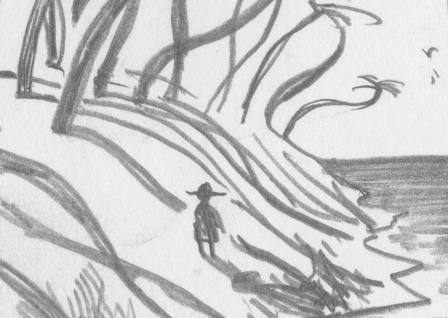
Hawaii 1997
Sam Alden
96 pages
Uncivilized books
ISBN: 0988901463 (Amazon)
Sam Alden as a fairly fresh member of the comics avant garde has put forth a number of pretty fantastic and creative works. Notable, to me at least, were Backyard and The Worm Troll—both tremendous early works. While Backyard might be the most visually stunning and The Worm Troll the most ingenious, it was Hawaii 1997 that most interacted with my heart, with my nostalgia for the struggles and adventures that a much younger me experienced.
Hawaii 1997 is the first of the two stories included in this small (5.25" x 7"!) volume and it's tremendous. I originally read the book in minicomics form, photocopied and stapled. It took me a bit by surprise and took a couple pages for me to adjust to the looseness of Alden's art here. After a few moments though, I fell into the piece. Then, in the book’s climax, there was a line spoken and it made me sit back and think: Daaaaaaaaaamn. It was one of those surrealistic moments that actually rings more true than most actual experiences we have. It was something I could get behind, something I could relate to, something I could taste. It was perfect. It held the pain and hope and sadness and desire of a nostalgia for a single memorable event from 20 years ago.
Hawaii 1997 is the superior story in the volume, but Anime (the other story) boast more impressive art. It's a look at a nerd girl and her obsession to the exclusion of reality. I was uncomfortable through the story even while recognizing Alden's massive talent. I'm not sure if the story is actually mean-spirited or if it's just plain impossible to have a story about an obsessed character without painting them in negative light.
101–110111–120121–130131–140141–150
151–160161–170171–180181–190191–200
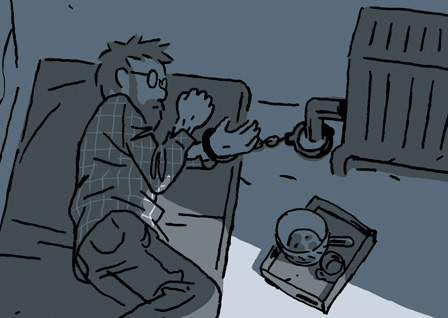
Hostage
Guy Delisle (translated by Helge Dascher)
436 pages
Drawn and Quarterly
ISBN: 1770462791 (Amazon)
This is going to sound like a weak recommendation but I don't mean it to be: Hostage is the perfect book to get from the library. At least it would have been for me. I don't need to own it—though I do.
It does its job really well. It relates Christophe André's real-life kidnapping from a Doctors Without Borders office and the time he spent as a hostage while negotiations for the One Million Dollars required for his release sputters and stalls and lurches and... well. The trouble is: when you're a hostage, you don't really get to do much. It's a lot of sitting there cuffed to a radiator and a lot of going slightly mad. A lot of nothing really at all. And Delisle, I think, nails this. As Anderé suffers from the sameyness of his routine, I suffered as a reader. His boredom was my boredom. Which, again, sounds like a knock on the book but it really really isn't—Delisle does exactly the right thing by not embellishing, by not turning André's time as a hostage into a thrill ride.
And at the same time, as boredom creeps in, there's this gradually rising sense of tension and anxiety. André feels it and because he feels it, the reader does too. Is today the day? Surely it will be today. What is happening? What are those noises? Will I be home in time for my sister's wedding in three months? They want how much?? Should I try to escape? I don't know where I am or the language at all. I don't know if everyone around is in on it or if I call help loudly enough will I be rescued. I could attempt an escape but I might just complicate things since my release will surely happen tomorrow. Oh, I... I'm going to die here aren't I?
The whole experience was excruciating and delicious and now that the tension is gone because I know exactly how everything plays out, I don't see myself reading the book again. It was great and while I don't regret owning it (because ownership means I can lend it), in retrospect I would have been fine checking it out from the library.
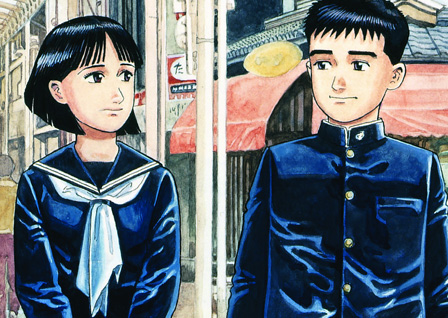
A Distant Neighborhood
Jiro Taniguchi
408 pages
Fanfare Ponent Mon
ISBN: 1910856037 (Amazon)
I first read this eight years ago. I guess I would have been in my mid thirties or something. Math is hard. I liked it. I love Taniguchi's art and I was still head-over-heels for The Walking Man. I liked A Distant Neighborhood but I didn't love it. I remember wanting to write a review of it but not really having anything to say beyond a lukewarm sort of congratulations. It felt too, I dunno, simple to me.
But now because of this series, I'm looking for different kinds of books to fill in the nooks and crannies of what I absolutely plan cover. So along with reading new material, I'm rereading older books that I've forgotten a bit. That's how Solanin got on the list a few weeks back—I reread it and was wowed and was reminded how much I liked it when it came out. Rereading A Distant Neighborhood last week, I see that the first time I read it, I was either looking for something else or maybe I just wasn't old enough in my experiences to really feel the weight of Taniguchi's world. Because while I liked it when I first read it, I loved it when I read it just now.
Hiroshi is 48 years old, a successful and alcoholic architect. He's distanced from his family. He may not have a mistress, but he's not above the occasional infidelity while he's away on business. One day, suffering from that kind of disassociation that might come after a night of heavy drinking, he boards the wrong train. Instead of heading toward home, he finds himself in the town where he'd grown up and the memories of his time there begin to trickle back. Exhausted, he falls asleep.
Waking, Hiroshi finds that he is back in his 14yo body and life. His mom is alive again, his dad hasn't left the family yet, he's back in school. It's all very disorienting but he doesn't seem to be waking up from a dream and as the weeks go by, he realizes this is his life now—a 48yo man in a 14yo boy's body. Which makes his taste for alcohol not work out so well. But more, he believes he may have the chance to prevent his dad from vanishing one night at the end of summer.
I'm much closer to Hiroshi's age now (even if our lives are vastly different) and it's a bit easier for me to see the things that motivate both him and his father. What struck me as simple before feels poignant now. And maybe you'll feel the same. Fanfare/Ponent Mon rereleased the series in a single volume recently and I recommend it to you.
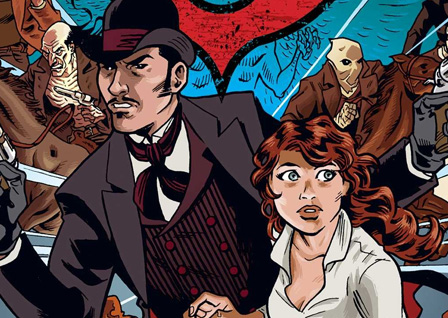
The Sixth Gun
Cullen Bunn and Brian Hurtt (colours by Bill Crabtree)
9 vols
Oni
ISBN: 1934964840 (Amazon)
It’s not easy to sell me on genre books, even when they combustibly mix genres with verve, spice, and zest. I’m perfectly happy to not investigate superhero books, westerns, or efforts that seek to out-Tolkien Tolkien. Vampires, werewolves, zombies, pirates, ninjas? None of these really do it for me. And even though I was once a savage, avid reader of noirish detective-fiction, I’ve passed on countless opportunities to engage some of the newer works in the genre.
So when I saw that the The Sixth Gun was a western horror adventure with melody that sounded like a cover-song of the BPRD's greatest hits, the elevation of my pulse remained resolutely subterranean. (I had read and barely enjoyed the Wild West volume of Mignola’s Witchfinder and didn’t feel I was in the market for anything near the same neighbourhood.) Though I had picked up the first volume of The Sixth Gun on word-of-mouth alone, upon discovering the provenance of its primary story elements, I quietly slipped it to the bottom of my reading queue.
I'm glad to say that though populated with ghosts and zombies and witches and witchdoctors and demons and wendigos and mummys and magic items and, well, the apocalypse—though populated with that kind of fanciful nonsense— Bunn and Hurtt's yarn about frontiersy America and the end of the world sings a delightful song. I was caught up not only in its characters (my entrypoint of choice into any story) but in its plotpoints as well. It's an exciting read and well-executed. The art is lovely and the writing better than competent (even if some of the narrative balloons lean a bit heavy on the repetitious, probably for the sake of its periodical readership).
There are lots of things that I could talk about but one of my personal favourite choices is when the female lead, Becky Montcrief, gets caught too near a blast of dynamite and her hearing goes temporarily. That's at the end of a chapter. The next chapter is entirely silent. No speech balloons, no sound effects. Then at the beginning of the next chapter, her hearing begins to return hesitatingly. She mentions this BUT there's never any overt explanation for why that one chapter was silent. Bunn allows the reader to be smart enough to piece it together on their own. A nice touch and he shows his respect for the reader in not beating them over the head with the moment.
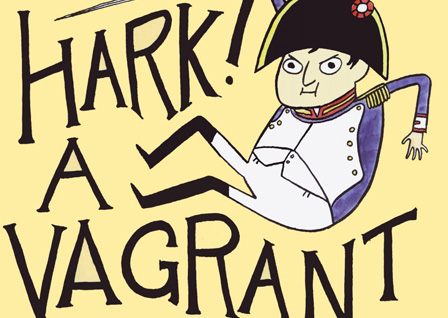
Hark a Vagrant
Kate Beaton
160 pages
Drawn and Quarterly
ISBN: 1770460608 (Amazon)
It takes a steady hand to string together an intricately woven, deeply nuanced plot. The number of authors who can take a handful of seemingly contrived elements and produce an elegantly composed narrative admixture are few and rare. Plot-heavy literature, when it succeeds, is a wonder to behold; but in its failure, we find little to surprise us. So when I describe Kate Beaton’s Hark A Vagrant! as paean to complex plot structures and hail it as deviously devised, I hope you’ll pay attention. The book is a marvel.
Of course some might blanch at seeing Beaton’s book described as plot-driven, but those are simply people who have not yet grasped the book’s primary aim, the goal to which it aspires and ably reaches. If Hark A Vagrant!'s single-minded storyline is to be described in succinct terms, here is probably the simplest explanation: Hark A Vagrant!'s plot is the story of how Kate Beaton made me laugh more than any author.
Hark A Vagrant! presents a collection of historically- and literary-minded humour strips that run the range from dry witticism to baudy toiletries. Being a fan of both history and literature probably helps a reader appreciate the particular kind of crack that Beaton’s cooking up, but there’s a lot of low-hanging fruit as well. Some of my favourite bits were a series of strips in which Beaton takes covers of Nancy Drew mysteries and extrapolates a scene or plotline based on those singular images. As well: there’s a bunch of Canadian stuff I didn’t get. Sorry Canada for knowing next to nothing about your history or culture (though I did recognize Louis Riel!). Beaton also does this wonderful thing where she’ll add commentary to select strips, somehow further ennobling the experience (and sometimes actually educating or at least piquing curiosities).
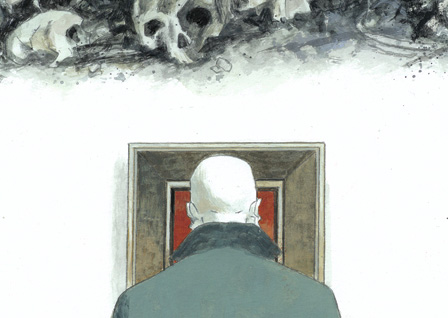
The Red/Re[a]d Diary
Teddy Kristiansen and Steven T. Seagle
144 pages
Image Comics
ISBN: 1607065606 (Amazon)
Explaining this book’s gimmick is almost certainly going to be obnoxious, but without the explanation it will be almost impossible to convey the wonder of the work. I’ll try to keep this brief.
The project began as a single book, Le Carnet Rouge, written and drawn by Seagle’s occasional collaborator, Teddy Kristiansen. Seagle loved Kristiansen’s art on the book and wanted to bring it over to America under Image’s Man of Action imprint—only Seagle would have to be directly involved in the book’s writing for the work to be published through Man of Action. And as the book was already written by Kristiansen, that wouldn’t fly. Seagle might have gotten away with publishing via a translation credit, but he speaks neither French nor Danish (Le Carnet Rouge had already been translated into Danish. So he came up with the bizarro gimmick that would give us two books in one (the volume is presented flipbook-style, with each story reading from its respective front cover to the book’s center).
Through a process Seagle terms transliteration (but is really nothing like what everyone else means by transliteration), Seagle took the Danish version of the text and adapted its sounds into something like English, then cleaned that up and massaged it into a coherent story. (In the end notes I’ll provide the example that Seagle uses to illustrate the process.) The surface-level trick is that his story is wildly different from Kristiansen’s. Using the same art. The real trick though is that both his version and Kristiansen’s are very good stories, regardless of either their process of generation or how very little they resemble each other.
Both tread some of the same thematic ground, exploring characters whose identities are in flux, who submit to war as means to escape the self, and both feature a man named William Ackroyd who seeks to untangle a history divulged through a collection of diaries. But in Kristiansen’s book, Ackroyd is a biographer researching a poet who stumbles upon a more interesting story. In Seagle’s, Ackroyd is a former artist whose works are celebrated though the War took his ability to produce. In Seagle’s, Ackroyd experienced the fullest measure of WWI’s trench warfare. In Kristiansen’s, Ackroyd may not have yet been born at the time of WWI. Both stories concern a British painter in 1910 Paris (Seagle specifies Montparnasse), but their stories and experiences are very different. Both end up fleeing Paris, but in Kristiansen’s in fear for his life and in Seagle’s in fear for his soul.
Both stories are excellent, but at less than seventy pages perhaps rather slight. Put together and in contradistinction, Kristiansen’s and Seagle’s sororal twin stories present a powerful exploration of both the human condition and the narrative craft. Taking the opportunity to tell the two fully different stories under an identical restrictive framework gives the reader a unique porthole through which to observe the vagaries of the human spirit. Where Seagle’s story might initially appear as mere technical exercise (perhaps a challenge to himself if nothing else), the final result is intriguing and entirely worthwhile. In comparing the two stories while reading—almost an inevitability due to the format of the project—the ingenuity of both creators is magnified through a sort of meta-story that extends beyond the words and plotlines and art.
Seagle provides an example of his process in the book’s backmatter (which is really actually middlematter since this is a flipbook). These are the opening lines of the book:
• Kunsten kan, på sin egan brutale måde, få alle til at føle en rus, som en frygtelig sygdom, men måske den smukkeste af alle sygdomme."
Through “transliteration” this becomes:
• Constant can father’s sin even brutality made for all til it falls in ruin some in foretelling wisdom men made the mistake of all wisdoms.
Then he cleans it up a bit:
• Forever will man’s sins of brutality make for mankind until it fall in ruin wisdom itself foretells that man makes his mistakes in the name of wisdom.
And finally another pass renders it:
• Forever will man’s sins of brutality make pain for all men—until they fall to ruin—who claim that their mistakes were made in the name of a greater wisdom.
Pretty weird, huh? Regardless, Seagle does something magical between the Danish and his final script. I don’t know just how much massaging was done to the text but I imagine that in places, the conscious reinvention had to be pretty substantial in order to maintain the fluidity of the narrative (especially with regard to names of characters).
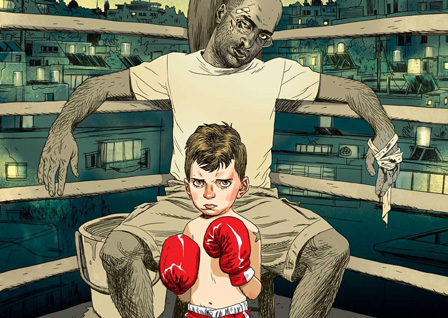
The Realist
Asaf Hanuka (translated by Jessica Cohen, Sari Cohen, and Tomer Hanuka, lettered by Deron Bennett and Asaf Hanuka)
192 pages
Archaia
ISBN: 1608866882 (Amazon)
Asaf Hanuka (whose last name sounds like the holiday) is an Iranian Jew living in Israel, married to—shoot, I forget—a Polish Jew? He is an illustrator and cartoonist, twin brother of a more renown illustrator and cartoonist. THE REALIST is a collection of his one-page slice-of-life comics depicting life in Israel under threat of war, life married to a beautiful woman you love but maybe not as much as you love mobile games, life addicted to social media dings, life in a complex world in which nothing you do doesn't somehow participate in the suffering of others.
His comics are wry, mirthful, tragic, lovely, exuberant, and sad. And SUPER imaginative. Very few of his comics don't at least have some sort of magical realism going on in them.
And unlike a lot of smug, bullcrap political cartooning, Hanuka's succeed because he constantly indicts himself. He isn't pointing to other people and saying Lookit these morons. He's pointing at himself and saying, I am like this and man aren't I kind of a big dumb moron.
It sounds navel-gazey and obnoxious maybe, but it really works.
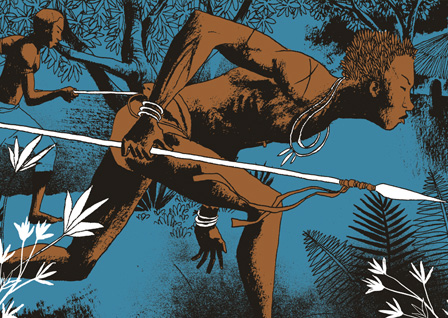
Run for It: Stories of Slaves Who Fought for Their Freedom
Marcelo D'salete (translated by Andrea Rosenberg)
180 pages
Fantagraphics
ISBN: 1683960491 (Amazon)
D'Saleto has created a sumptuous, frenetic book containing four short stories interacting with slavery in the Portuguese colonial history of Brazil. The stories are hard, girded in the diabolical truth of the human nature and capacity for the depraved. Still, though the slaves by nature of their bondage are always going to be on the losing side of the power struggle represented, there remains a kind of triumphalism, even sometimes in the midst of terrible betrayal and madness. Run For It offers a curious mix of the concrete tangible and the hallucinogenic magically real. It's a short but worthwhile experience.
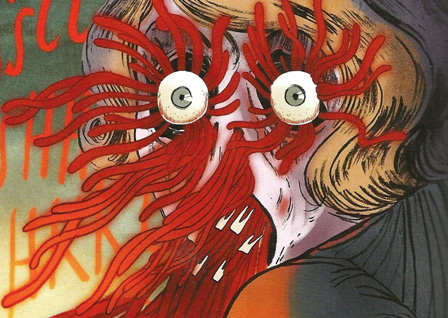
Through the Woods
Emily Carrol
208 pages
Margaret K. McElderry
ISBN: 1442465964 (Amazon)
Emily Carroll is among the top tier of contemporary horror graphic novelists, shining dark alongside Junji Ito. Rather than trade as heavily on the shock of the grotesque as Ito often does, Carroll works to build an atmosphere of terror. I mean, she does a brisk trade on the grotesque as well (and Ito can build the hell out of his atmosphere), but atmosphere seems to be her focus. Her stories are creepy and spooky rather than outright scary. Though of course, your mileage will vary. You can read one of her stories from the book, His Face All red, here.
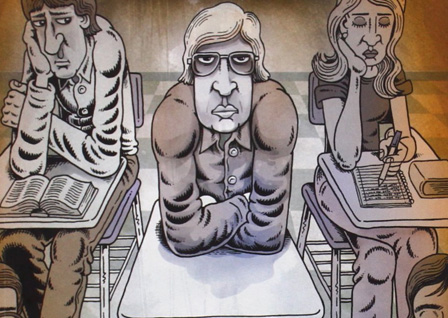
My Friend Dahmer
Derf Backderf
224 pages
Harry N. Abrams
ISBN: 1419702173 (Amazon)
While Backderf's telling of Jeffrey Dahmer's junior high and highschool formation is overly florid in narrative terms, it still succeeds in presenting the serial killer's history and day-to-day life in a way that engages the reader and pushes for evaluation of How Do We Get Here-type questions.
Backderf is in the wild position of both having known and gotten on well with a man who would become one of America's worst and most notorious serial killers, as well as being in the unique position to tell that story in an accessible way. My Friend Dahmer is not one of my favourite books but it *is* worth a read and worth considering after reading.
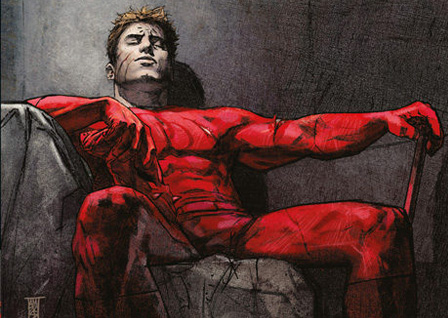
Daredevil
Brian Michael Bendis and Alex Maleev (coloured by Matt Holingsworth, lettered by Wes Abbott)
3 omnibus vols
Marvel
Amazon ID: B01FIWX0WY (Amazon)
Bendis and Maleev's Daredevil came out of nowhere and reinvigourated a series that hadn't been exciting since Ann Nocenti left around 1991. The story concerns Matt losing his secret identity but stridently pretending he still has it. And basically just what a mess his life becomes because of his inability to deal with trauma. So, standard Daredevil in a way, just done really well.
I mean, maybe the insistence that Matt was a ninja was a bit of a misfire...
101–110111–120121–130131–140141–150
151–160161–170171–180181–190191–200

Sin Titulo
Cameron Stewart
168 pages
Dark Horse
ISBN: 1616552484 (Amazon)
One of the things about worldbuilding we don’t often recognize is that it’s only tacitly the province of fantasy and sci-fi authors. Tolkien and Bradbury and Dick and Rowling and Martin are only showing us their amateur efforts in their novels. At the end of the day, a world you give a name is a world you’ve written off as one of your lesser creations. The real deals are those worlds that we continue to build and hone and craft across the landscape of our whole lives. We never think to name these because, really, what’s in a name? A cheap taxonomy? A way of excluding all the glorious and vibrant details? A commodification of our imaginative selves? Genuine worldbuilding is the cosmos we create and recreate with every waking experience—and a good number of those that ricochet through the meat of our subconciouses, informing our dreams and learning from the same. Genuine worldbuilding is not Middle Earth or Hogwarts or Westeros or Earthsea or whichever other podunk barely realized fantasy realm we’re so fond of. The real-deal worldbuilding takes place in every moment in the heads of every person across the globe. Billions and billions of worlds being constructed by the minute with a fidelity and complexity never imagined by any of the inhabitants of our favourite published fictions. It’s the unnamed, unpublished fictions that are the real majesties of the human creative spirit—only we’re so velocitized to their presence that we forget how incredible they are.
It’s in the connections that you and I forge between ourselves and the objects around us (whether animate or inanimate) that we develop the story of the world. The relationships that we draw up and then (magnificently) prove, whether between human or animal or vegetable or mineral or—most elusive of all—ideological, are fictions we craft to lend credibility to a universe that is plainly beyond the scope of any of our powers to comprehend. And because we are each of us so adept at worldbuilding, at composing a believable circumstance in which the stories of our lives might unravel themselves, we never blink at the suspension of disbelief that goes on when we do simple things like pay for gum in a supermarket line. Or when we attend a class on macroeconomics that we’re merely auditing. Or when we watch a Youtube parody of Peter Jackson’s film adaptation of JRR Tolkien’s published story version of a storyworld that he created long before he refined it for the page. We’re so talented that we would never dream of couching our interaction with the world in terms of suspended disbelief. It’s only when our worldbuilding conflicts with the builded worlds of those around us that we encounter dissonance.
(And from there come the frustrations and fights and divorces and murders and wars which comprise the bulk of both our nightly news and our entertainment.)
As the bulk of Stewart’s discussion of worldbuilding occurs in his climactic, expository finale, I’ll demur from speaking of it too specifically. The author does discuss the difference between worldbuilding and true worldbuilding, founding his argument on a sort of embellishment of the Platonic forms. He posits that the true artist’s concern is with creating reality rather than imitating it. In a way, we could read this as a dismissal of Tolkien-esque worldbuilding and a promotion of the kind of reality-forging that takes place in you and I in every moment. He doesn’t stop there and I’m not sure he or his characters would be entirely comfortable with this reading, but that’s the story within his story that affected me—the story of several characters trying to build realities in which they won’t be sickened by themselves and their weaknesses. A story that somewhat exists as pedagogy, a nudge to the reader toward an existence in which the stories we create for our lives eliminate our weakest selves and one in which our histories are not our fault.
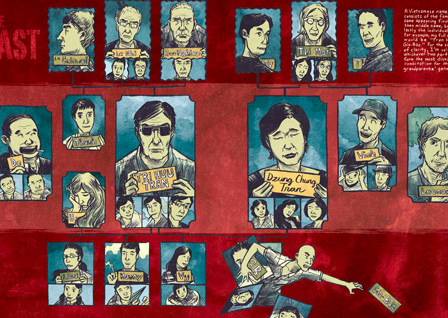
Vietnamerica: A Family's Journey
GB Tran
288 pages
Villard
ISBN: 0345508726 (Amazon)
In the book’s opening pages, Tran’s father chides the author for trying to judge things in Vietnam from a vantage of ignorance: “You can’t look at our family in a vacuum and apply your myopic contemporary Western filter to them.” In a way that Tran likely intended, the entirety of Vietnamerica can be read as an exploration of how to become liberated from such myopia through actively seeking revelation. Heartbreaking revelation, sure, but revelation like this, if it doesn’t sour us completely on the human animal, can build us into the beautiful people we might be. Certainly the Tran who wrote Vietnamerica is a more careful human being than the Tran that exists on the page.
Vietnamerica features a host of people who are simultaneously sympathetic and unsympathetic. Tran himself comes off in his younger days as apathetic and neglectful, caring little for whatever lives his parents might have had before they become the monolithic individuals he seems to see them as while he is growing up. His father is gruff and unrelenting, stoical and stereotypically demanding. His mother is argumentative and embittered by an American dream that turns out to be just another hard life. And yet his mother not only has reason to have been disenchanted and reason to be upset with her husband, but Tran shows that she is not just the caricature he concocted of her in his early twenties; after all it is through her own careful, passionate, and invested narration that much of Vietnamerica’s story unfolds. His father, in the end, is so much more than the broad stereotype he seems to inhabit and Tran’s investigation into the man’s inner character (in part aided by his mother’s narration) reveals, like the father suggests to the author earlier, that a one-sided perspective is inadequate for discovering who people are and what moves them. Even Tran himself does grow up—the publication of this beautiful book being primary evidence to his maturation.

Noah
Darren Aronofsky, Ari Handel, Niko Henrichon
256 pages
Image
ISBN: 1607068532 (Amazon)
Man, I avoided reading this for long enough. Huge fan of Aronofsky. Huge fan of an interesting exploration of the Hebrew mythos (actually a fan of crafty explorations of any ancient mythos). Completely nervous that this would suck so so bad. Bible stories are almost exclusively adapted into boring epics or into paint-by-numbers sterility. Nobody interacts with character motivation in responsible, believable ways.
What finally tipped the scale for me was seeing some screens of Nico Henrichon's art for the book. I was pretty wowed. I don't know if any of you had the "pleasure" of seeing some of the Bible comics that proliferated in the early '90s. I did. They were brutal. In my role as a comics critic, I've even seen some pages from comics Bibles released in the last decade and some contemporary attempts to create religious comics. It's all bad news. Aronofsky's Noah, though? This thing was beautiful. And nuanced. And complicated. And wild.
I'm half interested in seeing the film version now. I mean, I probably won't because who has the time. But I'm at least interested.
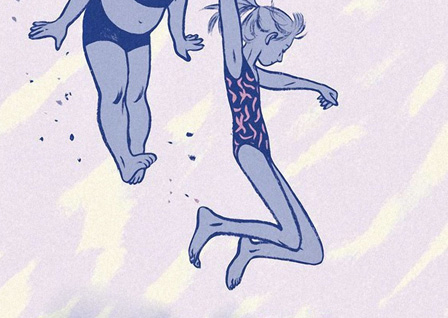
This One Summer
Mariko Tamaki, Jillian Tamaki
320 pages
First Second
ISBN: 159643774X (Amazon)
This One Summer is exactly the type of book we might threaten to describe as a distillation of nostalgia. It contains all the proper nostalgic elements—including among other things the recollection of the sort of coming-of-age events that drive maturation and spur consciousness expansion in the entirely non-spiritual sense of transitioning from child to near-adult. The title is even a bit of a gimme. This one summer. We’re hearing about what was. And we’re going to hear about it in a way that will prove at least somewhat consequential. There will be an end, a result, a lesson of some sort. You don’t begin a story by saying, “So, this one summer…” and then present merely a series of unrelated recollections. You’re telling a story about your past and therefore there will be a point. There has to be. You’re breathing life into your nostalgia and setting your creation free for others to love, judge, and interact with. Any story that begins with “This one summer” has to reframe history with a teleological scope—it has to indulge nostalgia.
The trick is that the blatant nostalgia-story isn’t really any different from the regular story. Every story we write, even future-fi, is a rebuilding of our pasts, our circumstances, and the stuff that made us. Gattaca drips as much nostalgia as Brighton Beach Memoirs, and The Matrix as much as Cinema Paradiso. It’s because the nature of storytelling is distillation. Whether you begin your yarn with “This one summer…” or “A long time ago in a galaxy far, far away…” you’re performing the same concatenating action, collapsing an entire world of histories into a single pericope. You’re making the big small. All to the end that you might celebrate a particular thing—a moment, a feeling, a person, a sense of being—whether that thing was present in the original happenstance or not. It doesn’t matter. You’re forging a new true thing out of your desire to make that thing known. The important thing, then, is not to recognize a story as being nostalgic (they all are) but to look for what makes this story, the one you’re reading right now, unique.
This One Summer contains masterful writing and masterful illustration certainly, but what does it convey? If, as I suspect, all stories are nostalgic, then what makes this particular story unique? If this is not to be read as some basking in the golden glow of our long-forgotten and longer-remembered youths, then what are the Tamakis circling here? Why do they wish to remind us of what happened this one summer?
While their answer might be (and probably would be) far different from my own, I think it essential to recognize This One Summer as an exploration of family, especially through the several women of varying ages who fill the story’s corners. At the center, of course, is Rose—a woman at the cusp, so to speak, of womanhood. She’s about thirteen and is that kind of bundled nerves, ideas, and curiosities that seem to almost universally mark the early teenage experience. She’s ignorant of a lot and wonders about sex, feeling some of the stomach-churning pull that physical attraction can hold for the uninitiated. Simultaneously, she’s protected by that kind of uncompassionate sociopathy that allows one human to hold no empathy for the concerns of others. When a local girl becomes accidentally pregnant by her local boyfriend who does his level best to abandon her via passive aggression, Rose cannot sympathize. The girl, to Rose, is simply a “slut”—and whatever that actually means, she is therefore unworthy of compassion. Rose’s mother is plagued by some acute tragedy, driven into depression and a colourless fatigue. And Rose’s reaction is to feel affronted and personally embittered. And yet there is a hope for Rose because by This One Summer's insistence in portraying women at all ages, we are driven to see that Rose is on a path rather than a fixed point. This One Summer is not her story. It is, instead, one of her stories. It is the smallest part of her story. It’s simply something that happened this one summer when she was not yet an adult and not quite any longer a kid.
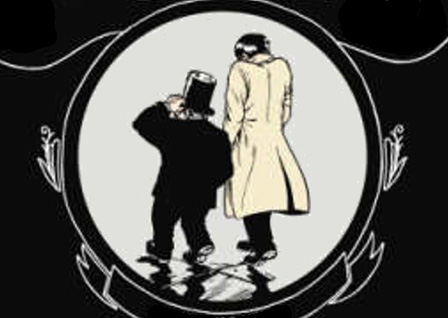
Jar of Fools: A Picture Story
Jason Lutes
152 pages
Drawn and Quarterly
ISBN: 1896597726 (Amazon)
Sad magicians make for good stories, film at 11:00. Scott McCloud point to Jar Of Fools often enough in Understanding Comics (or was it Reinventing Comics) that you just know there's some good comics magic at play here.
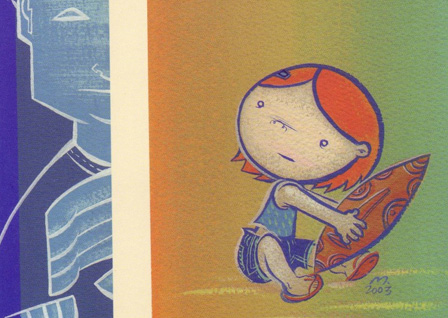
The Barefoot Serpent
Scott Morse
128 pages
Top Shelf
ISBN: 1891830376 (Amazon)
Morse bookends the story of a family (now of three) in Hawaii on vacation in the wake of the death of a child with a kind of children's book version of the life of Akira Kurosawa, highlighting the suicide of Kurosawa's older brother.
Beyond using Kurosawa's life and film career to lend thematic resonance to the central story, Barefoot Serpent is peculiar in that it is chiastically structured, which is not really something you see much of in contemporary Western narrative.
If you're looking for an interesting treatment of family loss or tragedy, this may be the right fit. Also, if you like Akira Kurosawa.

Night Fisher
R. Kikuo Johnson
144 pages
Fantagraphics
ISBN: 1560977191 (Amazon)
Johnson came on the scene with a roar of critical approval back in 2005 with his story of prep schools, Hawaii, and meth. That he didn't stay king of the hill always saddened me, but if he's doing things he loves, that's great.
(Also, there's no money in comics if you're not shilling tights or snappy-pattered sci-fi shenanigans or autobio about when you were a 12yo girl. Nothing wrong with those things but markets being what they are, it's virtually impossible to make a living in comics that don't sit squarely in one of a handful of genres.)
Annnnyway. Night Fisher looks a lot like Stray Bullets. Johnson's art and tonal sense is wonderful. The way he focuses his camera is artful. And like Lapham, he's not just doing straight crime but examining a life led. In Johnson's case, he's much deeper into the territory of the literary fiction novella than his in-genre contemporaries, and he uses the conceits of the form to portray motifs that give background music to the proceedings. Panels depict knot-tying instructions, recreations of placards illustrating local flora, maps of the islands' evolution, flights of fancy. It's all very interesting, even if not plot-forwarding. Especially when not plot forwarding.
And there are moments that move and break against your heart. Lovely, lovely work. I loved his greta-for-kids fable The Shark King, but I'll be honest that I want more than anything to see another effort from Johnson that equals or surpasses what he accomplished with Night Fisher.

Heck
Zander Cannon
284 pages
Top Shelf
ISBN: 160309301X (Amazon)
Hector "Heck" Hammarskjöld used to be a star footballer in highschool. He was the best, a hero, a legend. Now his dad's died and he's inherited the old business - which includes a house of relics with a gateway to hell. Heck runs a kind of adventure P.I. business where he takes dives into hell to locate the loved ones of his clients, delivering messages between the living and the lost. It's always a bit worse than he remembers, but he never remembers very much, so what the hell, right?
Zander Cannon delivers a funny, thrilling morality play based somewhat on Dante's hell. It's glib and it's heartfelt and it's pretty easily worth the time you'll spend reading it.
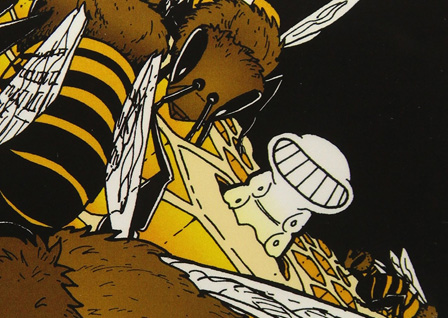
Clan Apis
Jay Hosler
160 pages
CreateSpace Independent Publishing
ISBN: 1482347458 (Amazon)
Clan Apis is a really cool way to explain the secret life of bees. It's non-fiction told through a fictioanl veneer, and it's really just chamring.

Koma
Pierre Wazem and Frederik Peeters (translated by Samantha Demers, coloured by Albertine Ralenti)
280 pages
Humanoids
ISBN: 1594651477 (Amazon)
A surreal adventure in which a young girl who falls unconscious (because her machine located in the underworld and maintained by a strange dark creature is defective) may be the only hope for the waking world—only in a completely non-shounen way. Peeters continues his trend of working on weird projects. It's a good trend and one he's well-suited for. And at one point we see precognitive echoes of some ideas we'd later see at work in Pachyderme (Koma is an older work, but only just localized for American consumption last year).
101–110111–120121–130131–140141–150
151–160161–170171–180181–190191–200
Good Ok Bad features reviews of comics, graphic novels, manga, et cetera using a rare and auspicious three-star rating system. Point systems are notoriously fiddly, so here it's been pared down to three simple possibilities:
3 Stars = Good
2 Stars = Ok
1 Star = Bad
I am Seth T. Hahne and these are my reviews.
Review copy submission may be facilitated via the Contact page.
Browse Reviews By
Other Features
- Popular Sections:
- Top 100
- Top 75 by Female Creators
- Kids Recommendations
- Daily Recommendations
- What I Read: A Reading Log
- Best Books of the Year:
- Top 75 of 2017
- Top 75 of 2016
- Top 75 of 2015
- Top 75 of 2014
- Top 35 of 2013
- Top 25 of 2012
- Top 10 of 2011
- Other Features:
- Why I ❤ Zita the Spacegirl
- 31 Days of Comics
- Bookclub Study Guides
- Sitemap










































































































